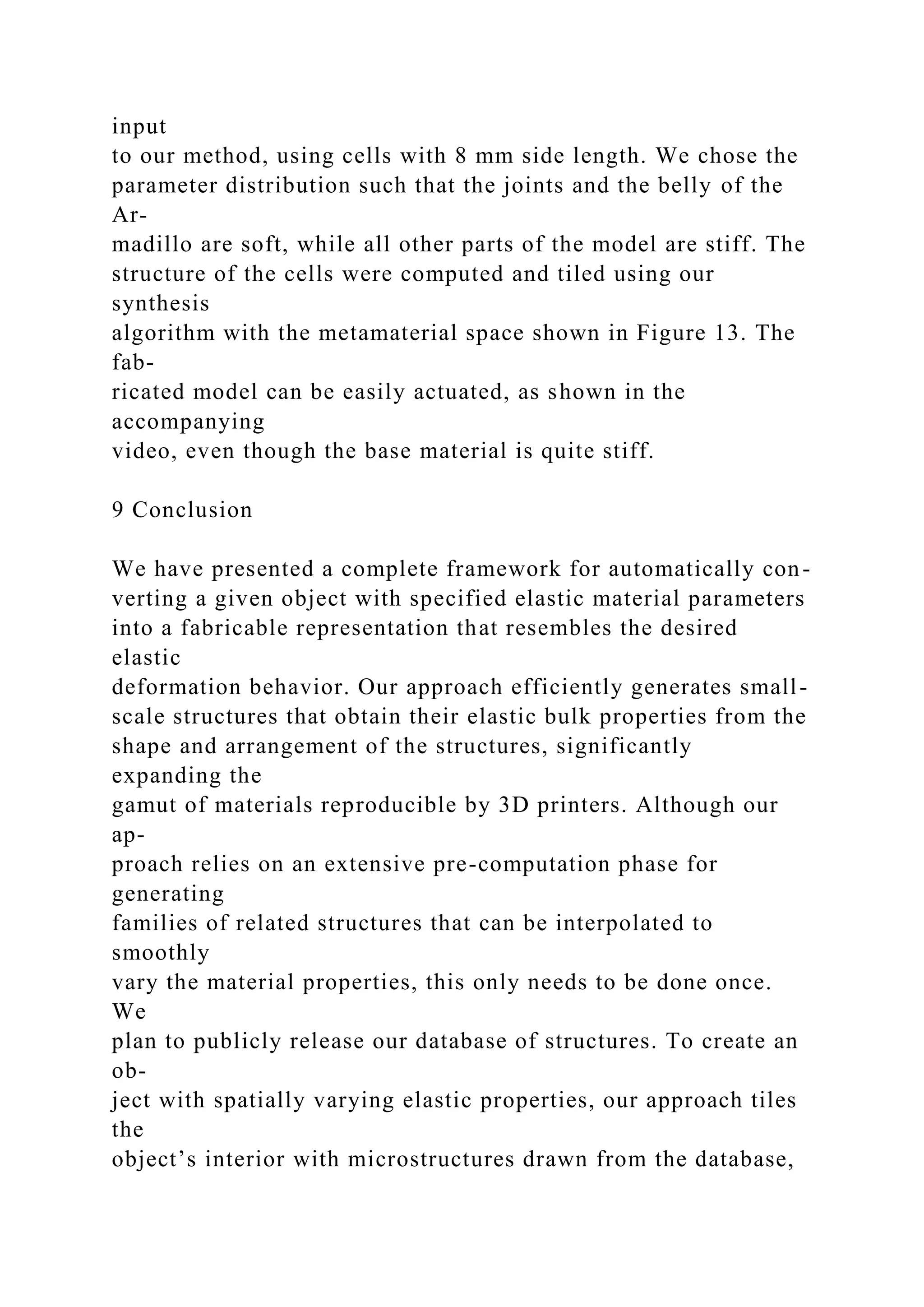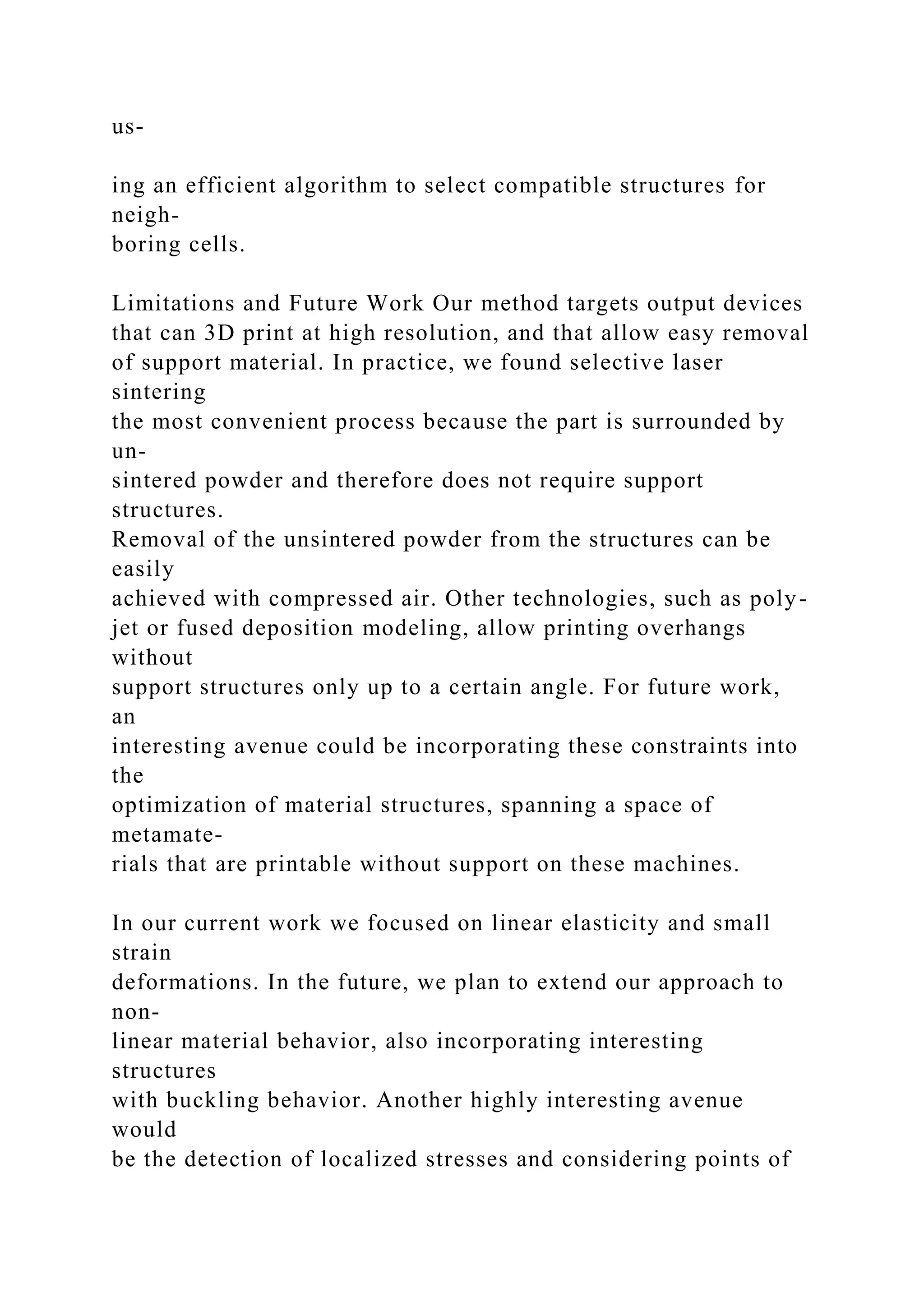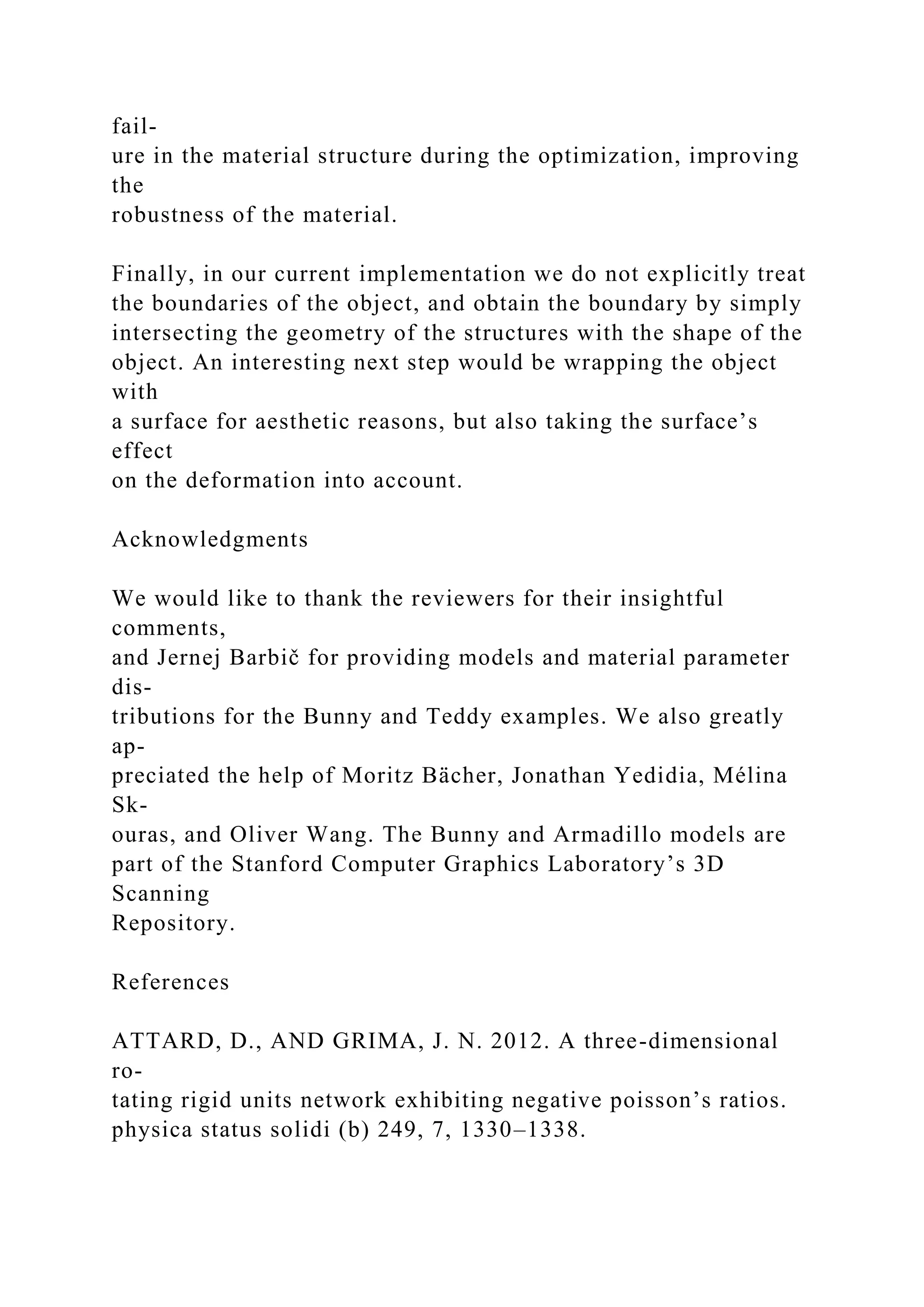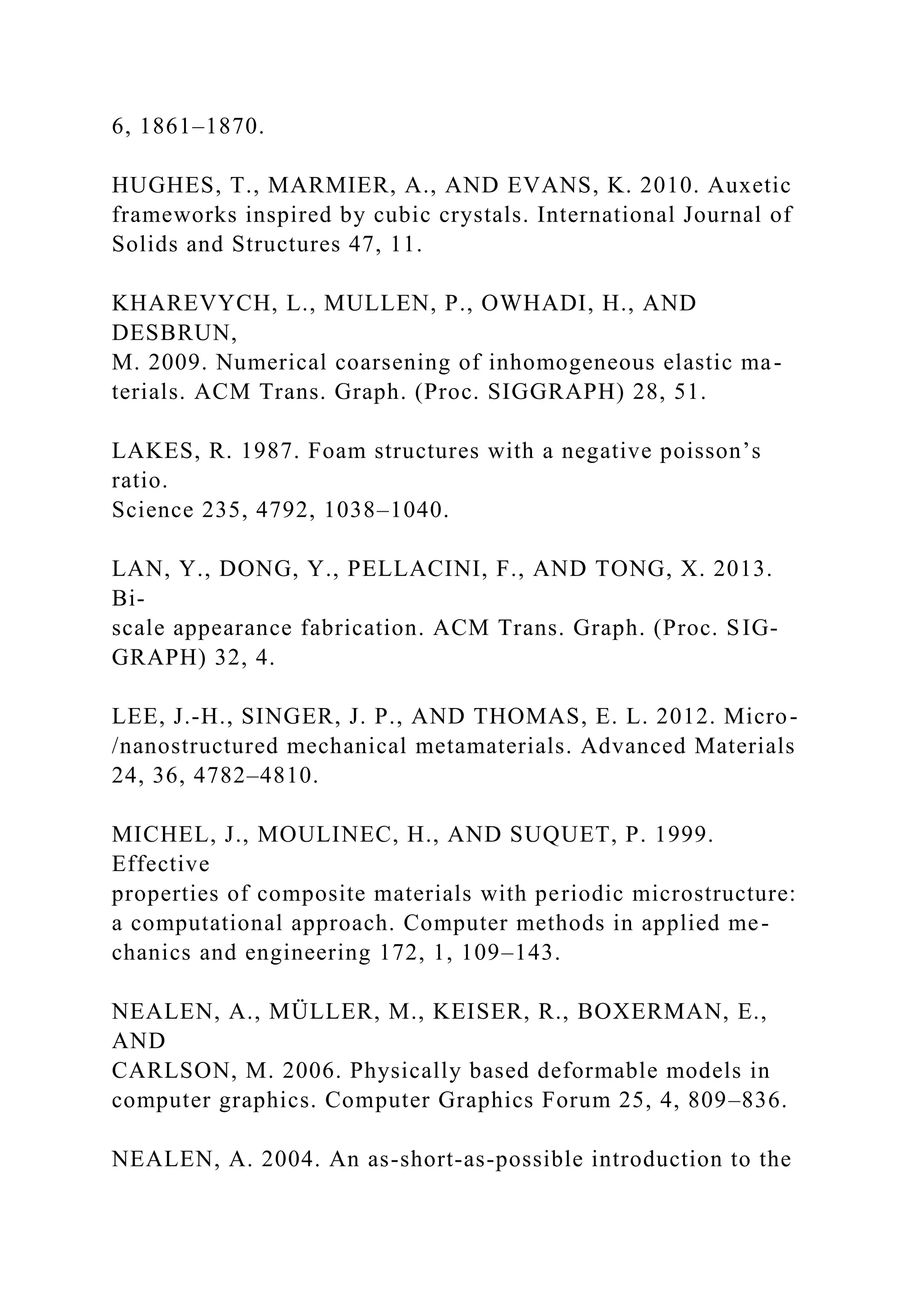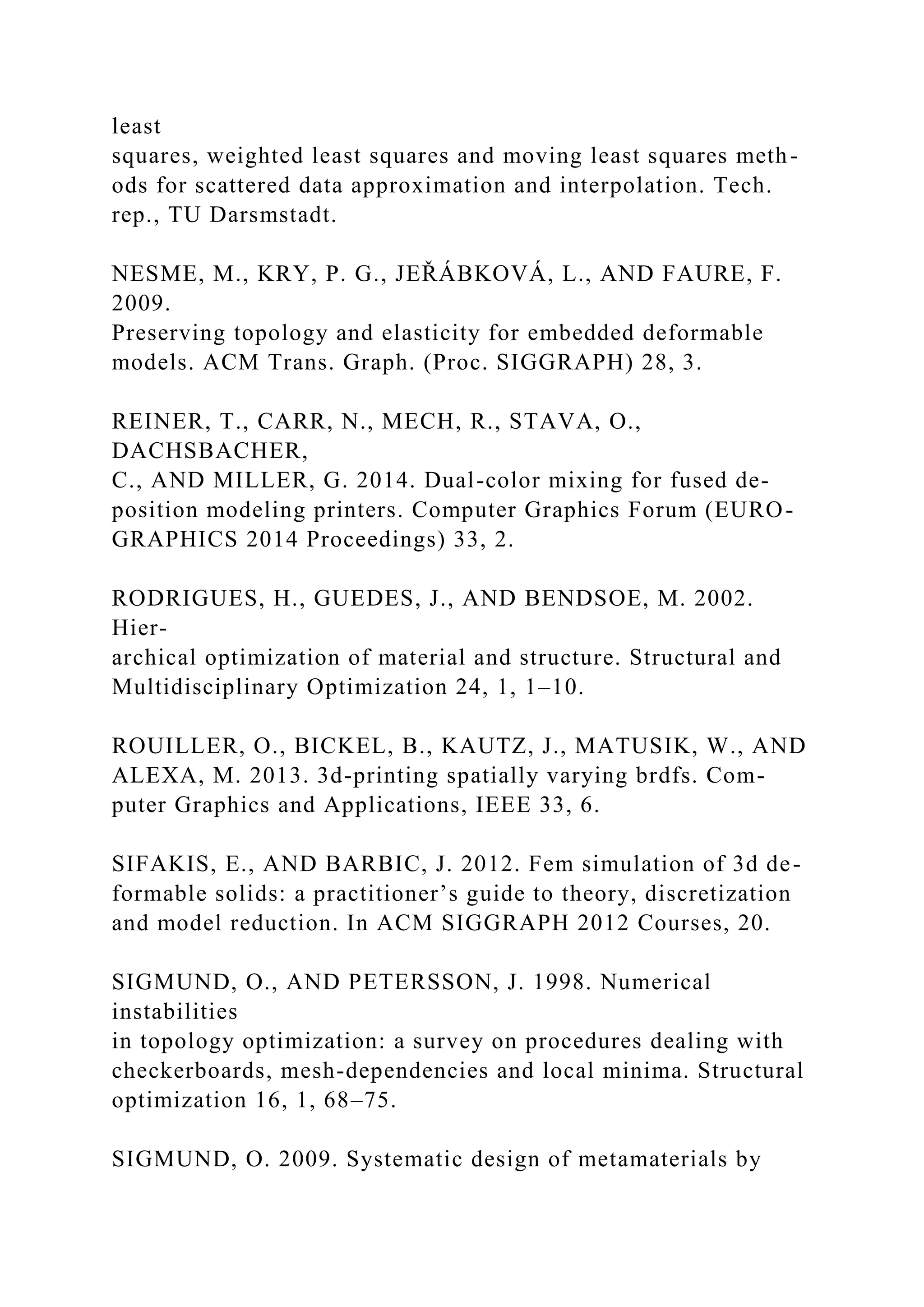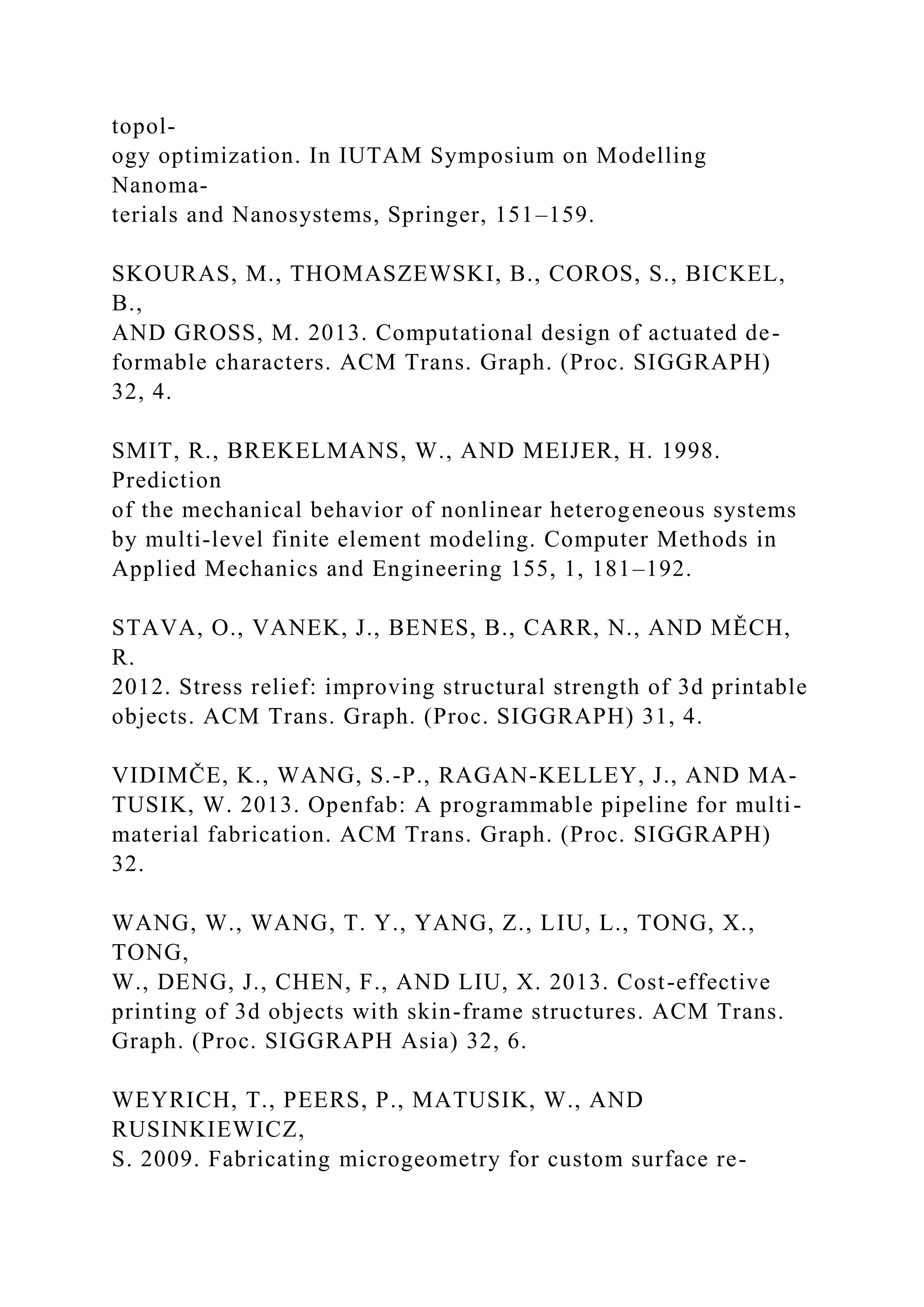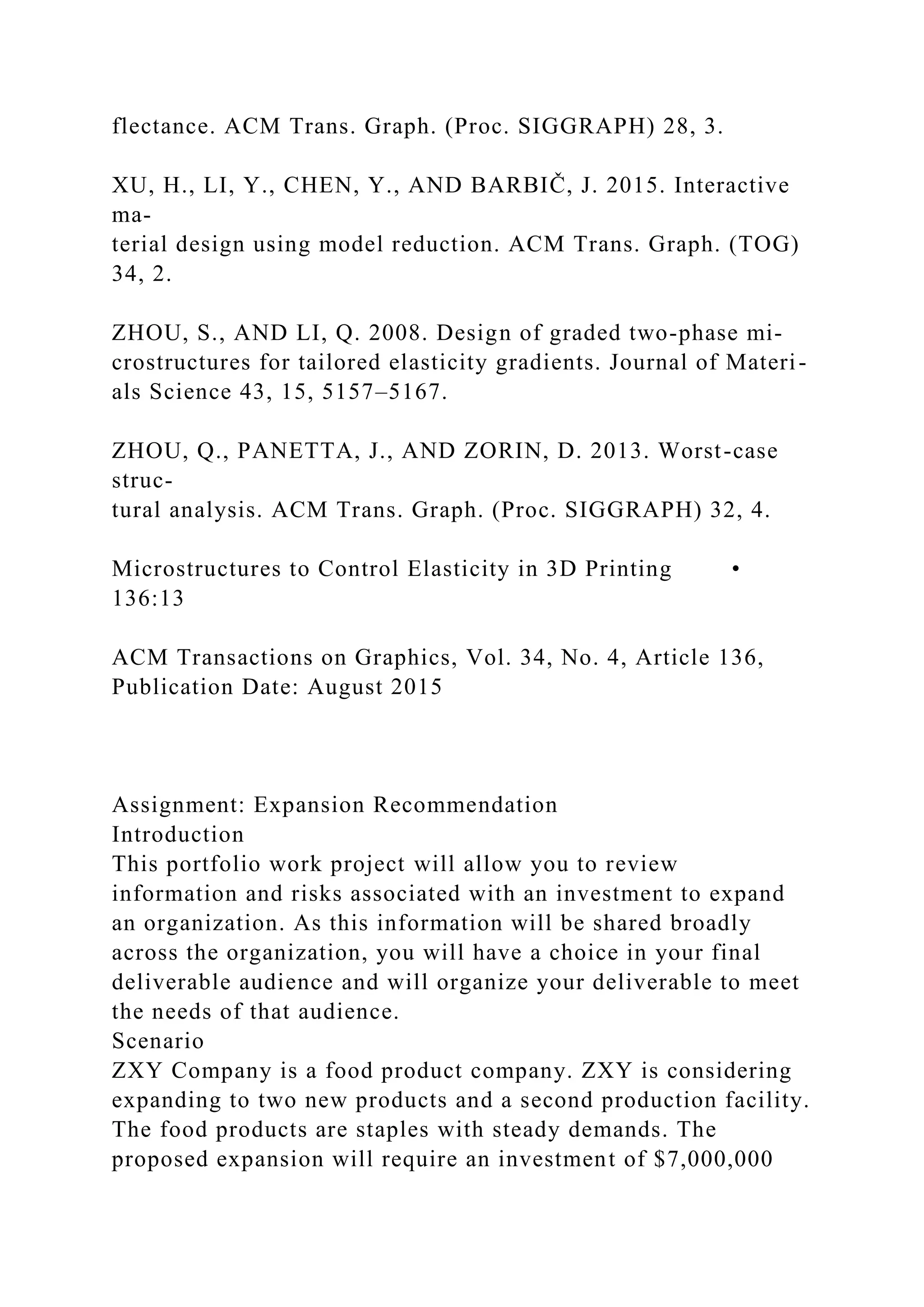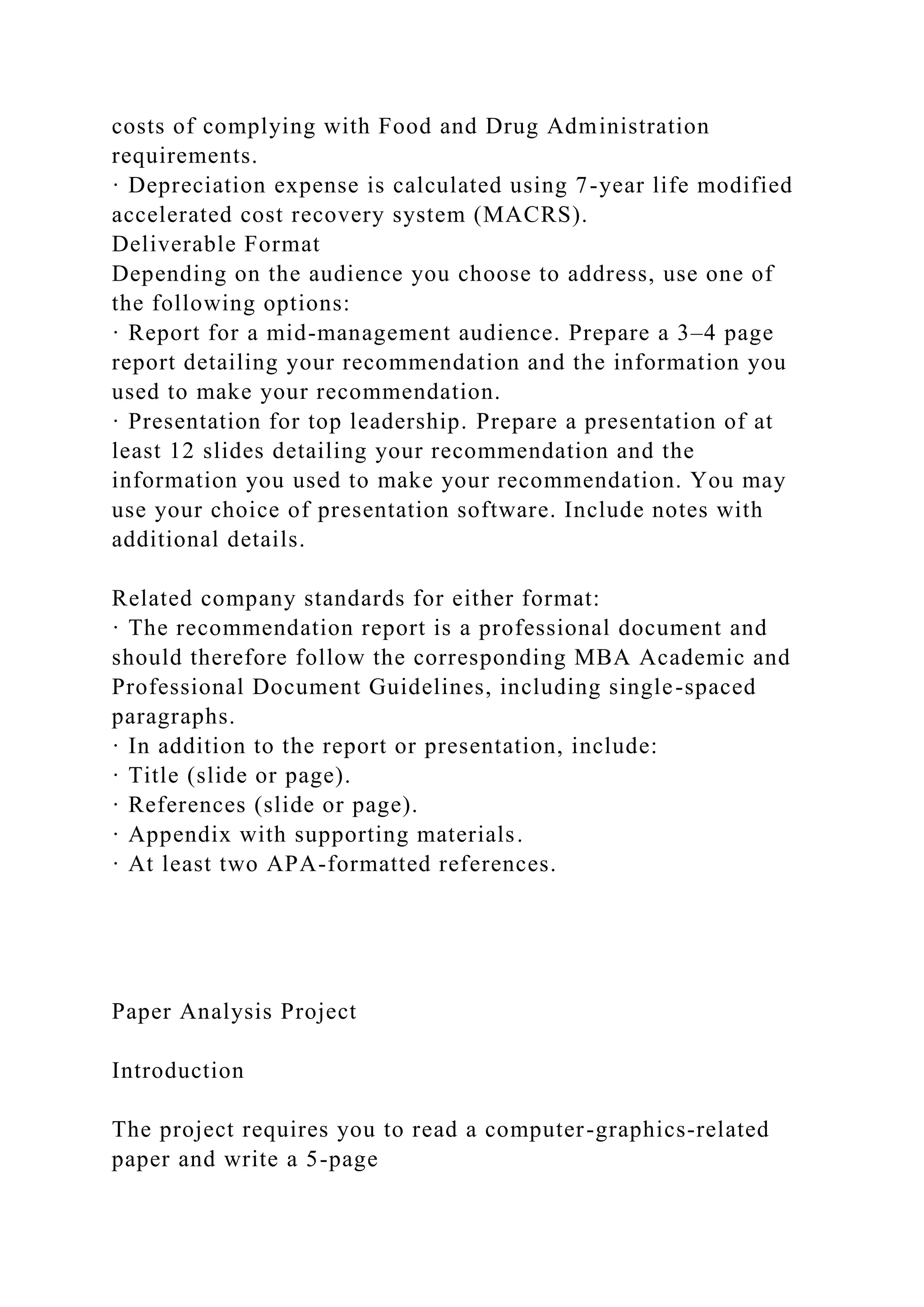The document presents a method for creating 3D printed objects with spatially varying elasticity using a single, relatively stiff material. It details how the method utilizes small-scale microstructures to approximate desired elastic properties, allowing for diverse mechanical behaviors in the printed items. The authors validate their approach through several experiments with both 2D and 3D printed examples, emphasizing the efficiency and potential applications of this technology in 3D printing workflows.
![ACM Reference Format
Schumacher, C., Bickel, B., Rys, J., Marschner, S., Daraio, C.,
Gross, M. 2015. Microstructures to Control
Elasticity in 3D Printing. ACM Trans. Graph. 34, 4, Article 136
(August 2015), 13 pages.
DOI = 10.1145/2766926 http://doi.acm.org/10.1145/2766926.
Copyright Notice
Permission to make digital or hard copies of all or part of this
work for personal or classroom use is granted
without fee provided that copies are not made or distributed for
profi t or commercial advantage and that
copies bear this notice and the full citation on the fi rst page.
Copyrights for components of this work owned
by others than the author(s) must be honored. Abstracting with
credit is permitted. To copy otherwise, or re-
publish, to post on servers or to redistribute to lists, requires
prior specifi c permission and/or a fee. Request
permissions from [email protected]
SIGGRAPH ‘15 Technical Paper, August 09 – 13, 2015, Los
Angeles, CA.
Copyright is held by the owner/author(s). Publication rights
licensed to ACM.
ACM 978-1-4503-3331-3/15/08 ... $15.00.
DOI: http://dx.doi.org/10.1145/2766926
Microstructures to Control Elasticity in 3D Printing
Christian Schumacher1,2 Bernd Bickel1,3 Jan Rys2 Steve
Marschner4 Chiara Daraio2 Markus Gross1,2
1Disney Research Zurich 2ETH Zurich 3IST Austria 4Cornell](https://image.slidesharecdn.com/acmreferenceformatschumacherc-221014034045-09a470de/75/ACM-Reference-FormatSchumacher-C-Bickel-B-Rys-J-Mar-docx-1-2048.jpg)
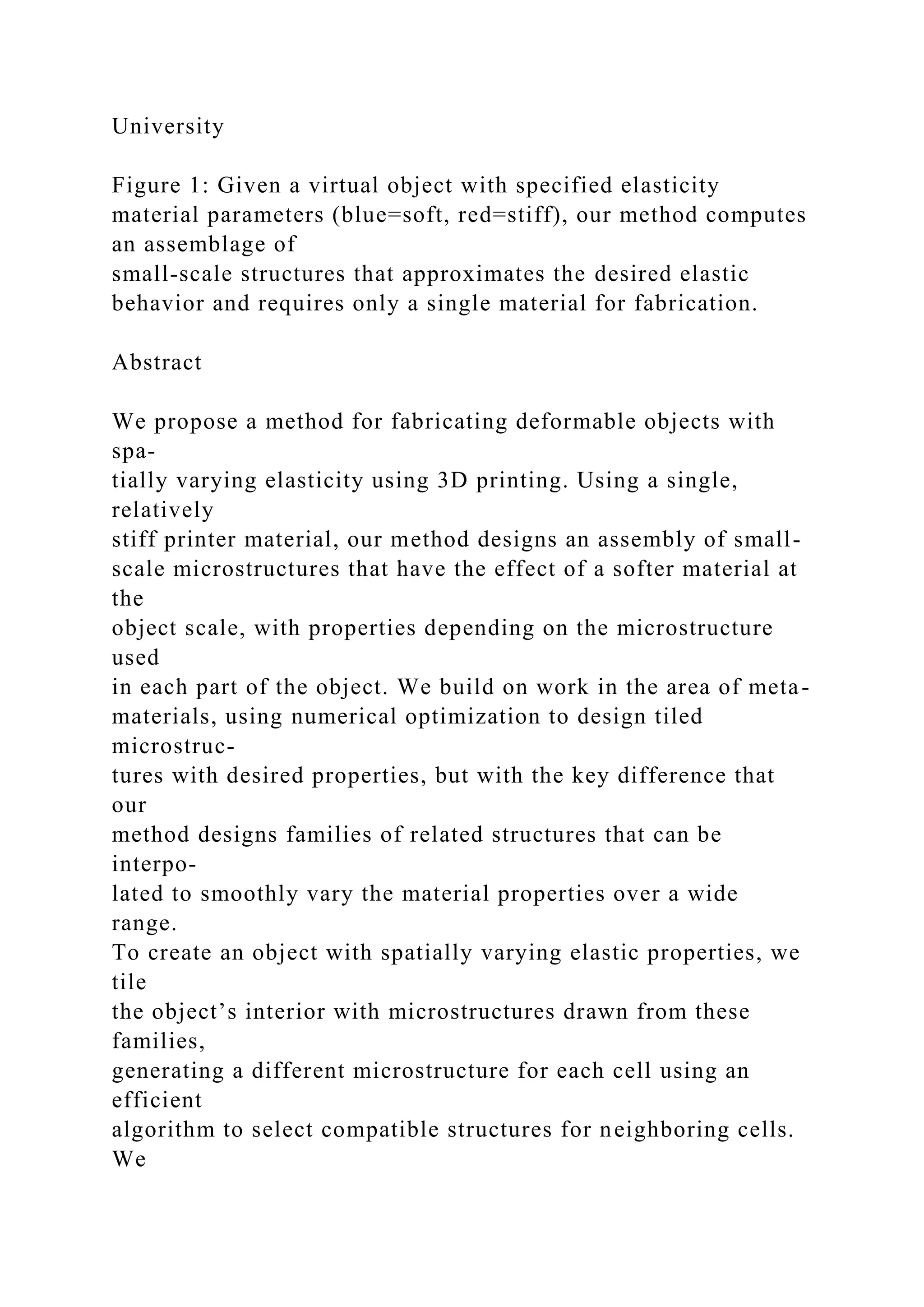
![show results computed for both 2D and 3D objects, validating
sev-
eral 2D and 3D printed structures using standard material tests
as
well as demonstrating various example applications.
CR Categories: I.3.5 [Computer Graphics]: Computational Ge-
ometry and Object Modeling—Physically based modeling
Keywords: fabrication, topology optimization, 3D printing
1 Introduction
With the emergence of affordable 3D printing hardware and on-
line 3D printing services, additive manufacturing technology
comes
with the promise to make the creation of complex functional
phys-
ical artifacts as easy as providing a virtual description. Many
func-
tional objects in our everyday life consist of elastic, deformable
material, and the material properties are often inextricably
linked to
function. Unfortunately, elastic properties are not as easy to
control
as geometry, since additive manufacturing technologies can
usually
use only a single material, or a very small set of materials,
which
often do not match the desired elastic deformation behavior.
How-
ever, 3D printing easily creates complex, high-resolution 3D
struc-
tures, enabling the creation of metamaterials with properties
that](https://image.slidesharecdn.com/acmreferenceformatschumacherc-221014034045-09a470de/75/ACM-Reference-FormatSchumacher-C-Bickel-B-Rys-J-Mar-docx-3-2048.jpg)
![are otherwise unachievable with available printer materials.
Metamaterials are assemblies of small-scale structures that
obtain
their bulk properties from the shape and arrangement of the
struc-
tures rather than from the composition of the material itself. For
example, based on this principle, Lakes [1987] presented the
first
engineered materials that exhibit a negative Poisson’s ratio.
Since
then, numerous designs have been proposed, usually consisting
of
a periodic tiling of a basic pattern, and engineering their
structures
is an active area of research [Lee et al. 2012].
While designing a tiled microstructure to match given homoge-
neous material properties can be achieved with modest
extensions
to the state of the art, designing a complex microstructural
assem-
bly to achieve heterogeneous, spatially varying properties is
much
more challenging. We face a complex inverse problem: to deter-
mine a discrete small-scale material distribution at the
resolution
of the 3D printer that yields the desired macroscopic elastic
behav-
ior. Inverse problems of this type have been explored for
designing
periodic structures that can be tiled to synthesize homogeneous
vol-
umes, but the methods are computation-intensive and do not
scale
to designing non-periodic structures for objects with spatially](https://image.slidesharecdn.com/acmreferenceformatschumacherc-221014034045-09a470de/75/ACM-Reference-FormatSchumacher-C-Bickel-B-Rys-J-Mar-docx-4-2048.jpg)
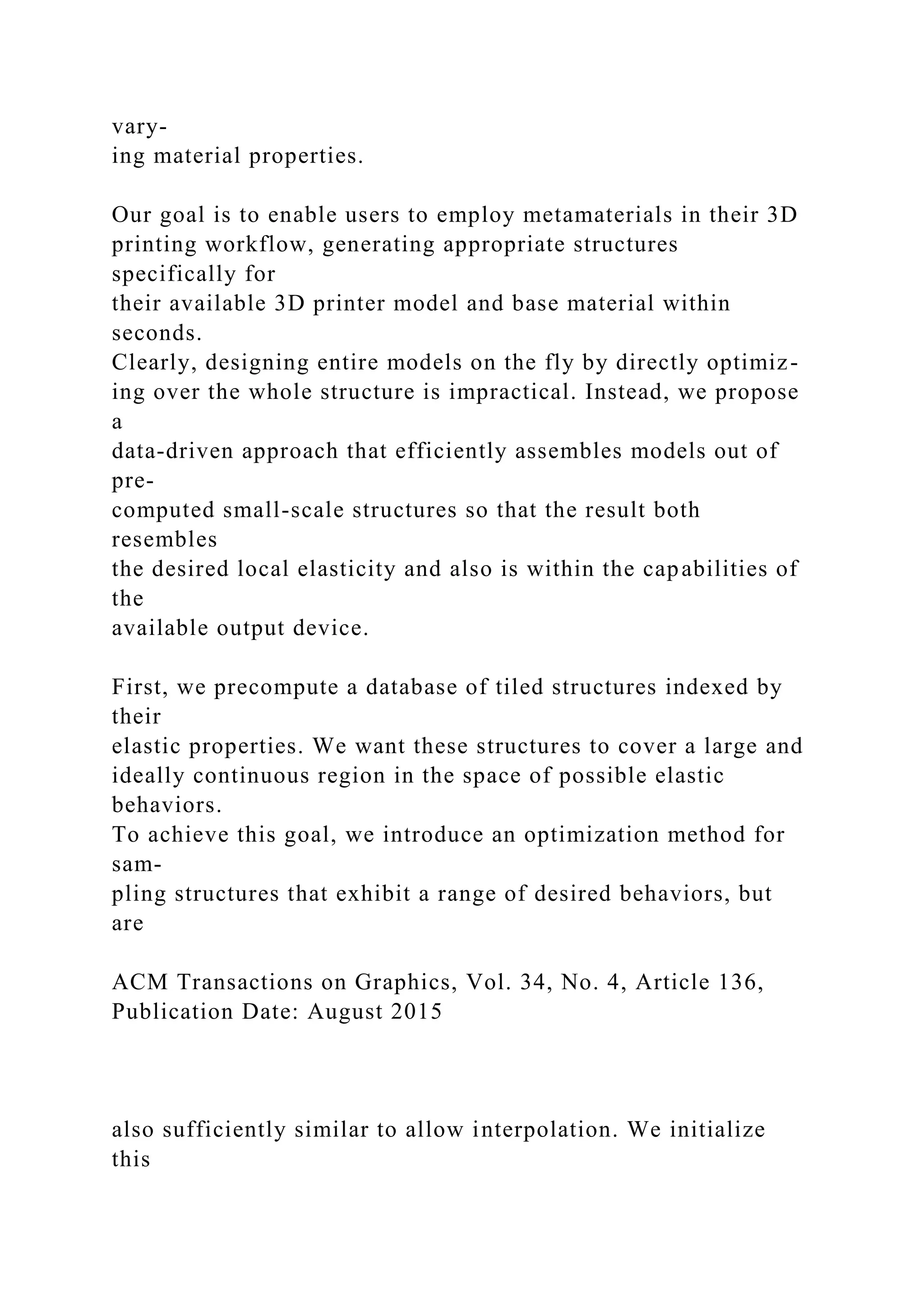
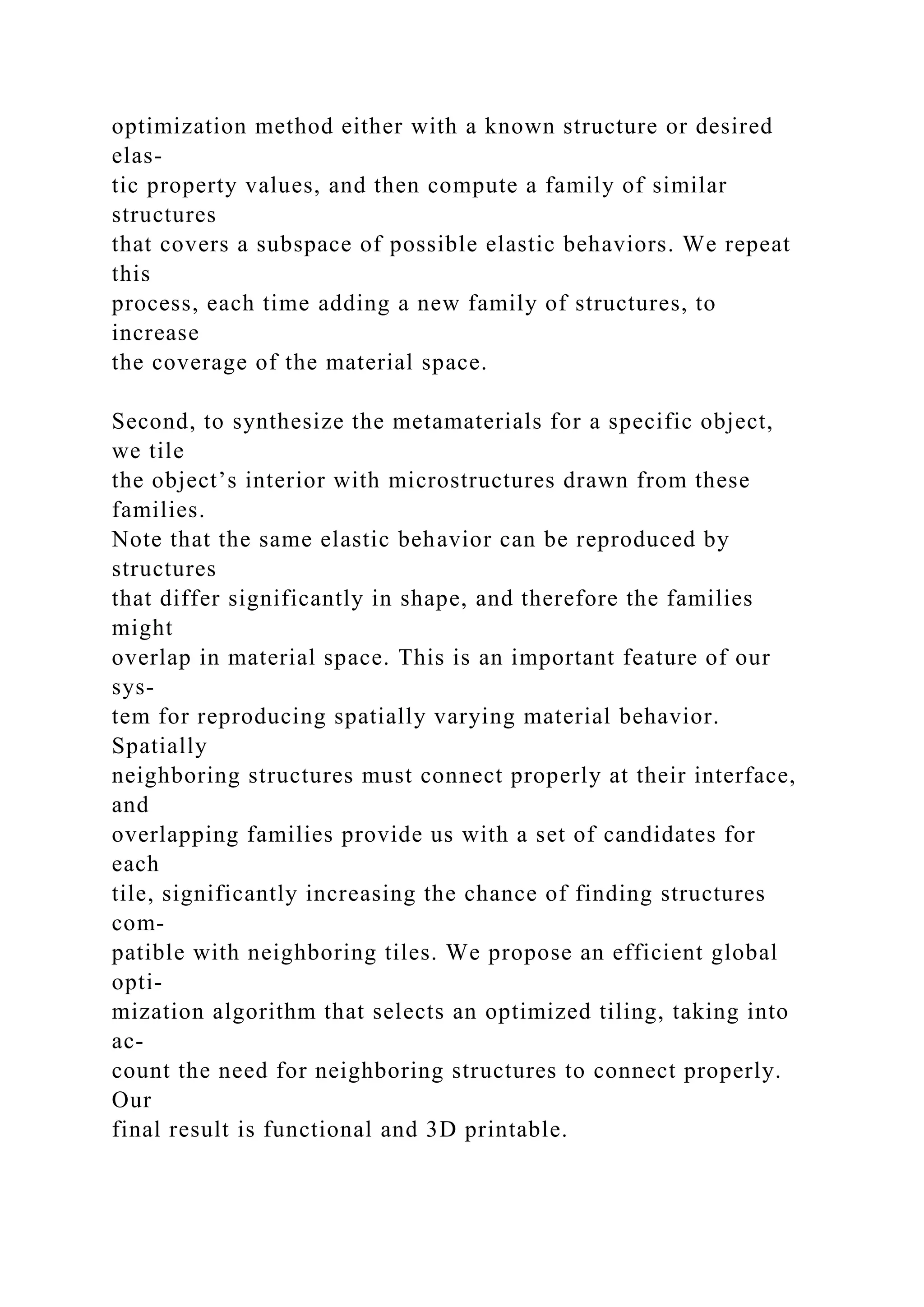
![We evaluate our algorithm by fabricating several examples of
both
flat sheets and 3D objects with heterogeneous material
behavior.
For several isotropic and anisotropic 2D examples and isotropic
3D
examples, we measure the resulting elastic properties,
comparing
the actual material parameters to the values predicted by our
simu-
lation.
2 Related Work
Simulation and Homogenization Simulation of deformable ob-
jects has a long history in computer graphics [Nealen et al.
2006].
For accurate simulation of material behavior, the finite element
method is a popular choice, with a wide range of available
constitu-
tive models of materials. An excellent introduction can be found
in
Sifakis and Barbič [2012]. Inspired by the seminal work of
Hashin
and Shtrikman [1963], homogenization theory was developed to
ef-
ficiently simulate inhomogeneous materials with fine structures,
al-
lowing microscopic behavior to be averaged into a coarser
macro-
scopic representation with equivalent behavior at the
macroscopic
scale [Michel et al. 1999; Cioranescu and Donato 2000]. Nesme
et al. [2009] encode the material stiffness within coarse
elements
using shape functions after a fine-level static analysis. We build](https://image.slidesharecdn.com/acmreferenceformatschumacherc-221014034045-09a470de/75/ACM-Reference-FormatSchumacher-C-Bickel-B-Rys-J-Mar-docx-7-2048.jpg)
![on the numerical coarsening approach by Kharevych et al.
[2009]
which turns the heterogeneous elastic properties represented by
a
fine mesh into possibly anisotropic elastic properties of a coarse
mesh that effectively captures the same physical behavior. After
computing harmonic displacements to capture how the fine
mesh
behaves, their approach presents an analytic relationship
between
the elasticity tensors of a coarse element and the elasticity
tensors
of the fine elements contained within. We extend this
formulation
for inverse homogenization.
Mechanical Metamaterials and Inverse Homogenization
Metamaterials are usually defined as macroscopic composites
having a manmade, periodic cellular architecture designed to
produce a behavior not available in nature. In this paper, we
draw
inspiration from mechanical metamaterials, and relax the term
in
the context of 3D printing to material properties not available
on
3D printers. Lakes [1987] presented the first engineered
materials
that exhibit a negative Poisson’s ratio. Due to their structure,
these
materials expand laterally when stretched, therefore increasing
their volume. Since then, numerous designs for soft
metamaterials
have been proposed, either found by intuition, or numerical
optimization processes [Lee et al. 2012].
In classical inverse homogenization approaches the goal is to](https://image.slidesharecdn.com/acmreferenceformatschumacherc-221014034045-09a470de/75/ACM-Reference-FormatSchumacher-C-Bickel-B-Rys-J-Mar-docx-8-2048.jpg)
![find
a repetitive small-scale structure with desired macroscopic
prop-
erties. This is obtained by optimizing the material distribution
in the base cell. Researchers have proposed various
parametriza-
tions of the material distribution, such as networks of bending
beams [Hughes et al. 2010], spherical shells patterned with an
ar-
ray of circular voids [Babaee et al. 2013], or rigid units [Attard
and Grima 2012]. Alternatively, the domain of a base cell can
be
discretized into small material voxels, and a discrete value
prob-
lem has to be solved. Due to the combinatorial complexity, di-
rect search methods are prohibitively expensive, and the
problem
is usually solved using a relaxed formulation with continuous
ma-
terial density variables [Sigmund 2009] or advanced search
heuris-
tics [Huang et al. 2011]. These approaches generally search for
structures with extreme properties, often maximum stiffness, for
a
given amount of material, and only consider a single structure.
In
contrast, we present an optimization method that computes a
struc-
ture to achieve a specific material behavior. Based on this
method,
we span an entire space of elastic material structures, and
construct
a mapping from elasticity parameters to microstructures that can
be
efficiently evaluated during runtime.](https://image.slidesharecdn.com/acmreferenceformatschumacherc-221014034045-09a470de/75/ACM-Reference-FormatSchumacher-C-Bickel-B-Rys-J-Mar-docx-9-2048.jpg)
![Rodrigues et al. [2002] and Coelho et al. [2008] suggest
methods
for hierarchical topology optimization, computing a continuous
ma-
terial distribution on a coarse level and matching
microstructures
for each coarse cell. While in their approach each
microstructure
cell can be optimized independently, each of them still needs to
be
computed based on a costly optimization scheme, and there is
no
guarantee on the connectivity of neighboring structures. In con-
trast, we use a data-driven approach which allows us to synthe-
size structures extremely efficiently, and also take the quality of
the connectivity into account. For functionally graded materials
with microstructures, Zhou et al. [2008] guarantee the matching
of
boundaries either by prescribing connectors or by incorporating
a
complete row of cells that form a gradient during a single
optimiza-
tion. We follow a different strategy. Instead of restricting types
of
connections or increasing the size of structures, we efficiently
com-
pute multiple candidates from families of microstructures and
then
select structures with interfaces that match best.
Fabrication-Oriented Material Design In computer graphics,
we are currently witnessing an increasing interest in
fabrication-
oriented material design for reproducing 3D physical artifacts
from](https://image.slidesharecdn.com/acmreferenceformatschumacherc-221014034045-09a470de/75/ACM-Reference-FormatSchumacher-C-Bickel-B-Rys-J-Mar-docx-10-2048.jpg)
![virtual representations. Recently, Chen et al. [2013] presented
an
abstraction mechanism for translating functional specifications
to
fabricable 3D prints, and Vidimče et al. [2013] introduced a
pro-
grammable pipeline for procedural evaluation of geometric
detail
and material composition, allowing models to be specified
easily
and efficiently. For static objects, Zhou et al. [2013] present an
al-
gorithm for efficiently analyzing the structural strength, and
Stava
et al. [Stava et al. 2012] improve the structural strength by
auto-
matic hollowing, thickening, and strut insertion. Wang et al.
[Wang
et al. 2013] propose a method for computing skin-frame
structures
for the purpose of reducing the material cost of the printed
object.
Recent work also investigated the reproduction of appearance,
for
example by modulating the surface structure to achieve desired
re-
flection properties [Weyrich et al. 2009; Lan et al. 2013;
Rouiller
et al. 2013], by interleaving different colored materials on the
sur-
face [Reiner et al. 2014], or by volumetric combination of
multiple
materials [Hašan et al. 2010; Dong et al. 2010] to control
subsurface
scattering behavior. Conceptually similar to our approach, these](https://image.slidesharecdn.com/acmreferenceformatschumacherc-221014034045-09a470de/75/ACM-Reference-FormatSchumacher-C-Bickel-B-Rys-J-Mar-docx-11-2048.jpg)
![methods are based on the principle that the large-scale
appearance
is governed by small-scale details, and can reproduce
appearance
properties which are significantly different from the 3D
printer’s
base material.
Bickel et al. [2010] presented a data-driven process for
designing
136:2 • C. Schumacher et al.
ACM Transactions on Graphics, Vol. 34, No. 4, Article 136,
Publication Date: August 2015
pre-process: metamaterial family construction run-time:
synthesis
microstructure
optimization
material space
sampling
input material
parameters
microstructure
synthesis
tiling
optimization](https://image.slidesharecdn.com/acmreferenceformatschumacherc-221014034045-09a470de/75/ACM-Reference-FormatSchumacher-C-Bickel-B-Rys-J-Mar-docx-12-2048.jpg)
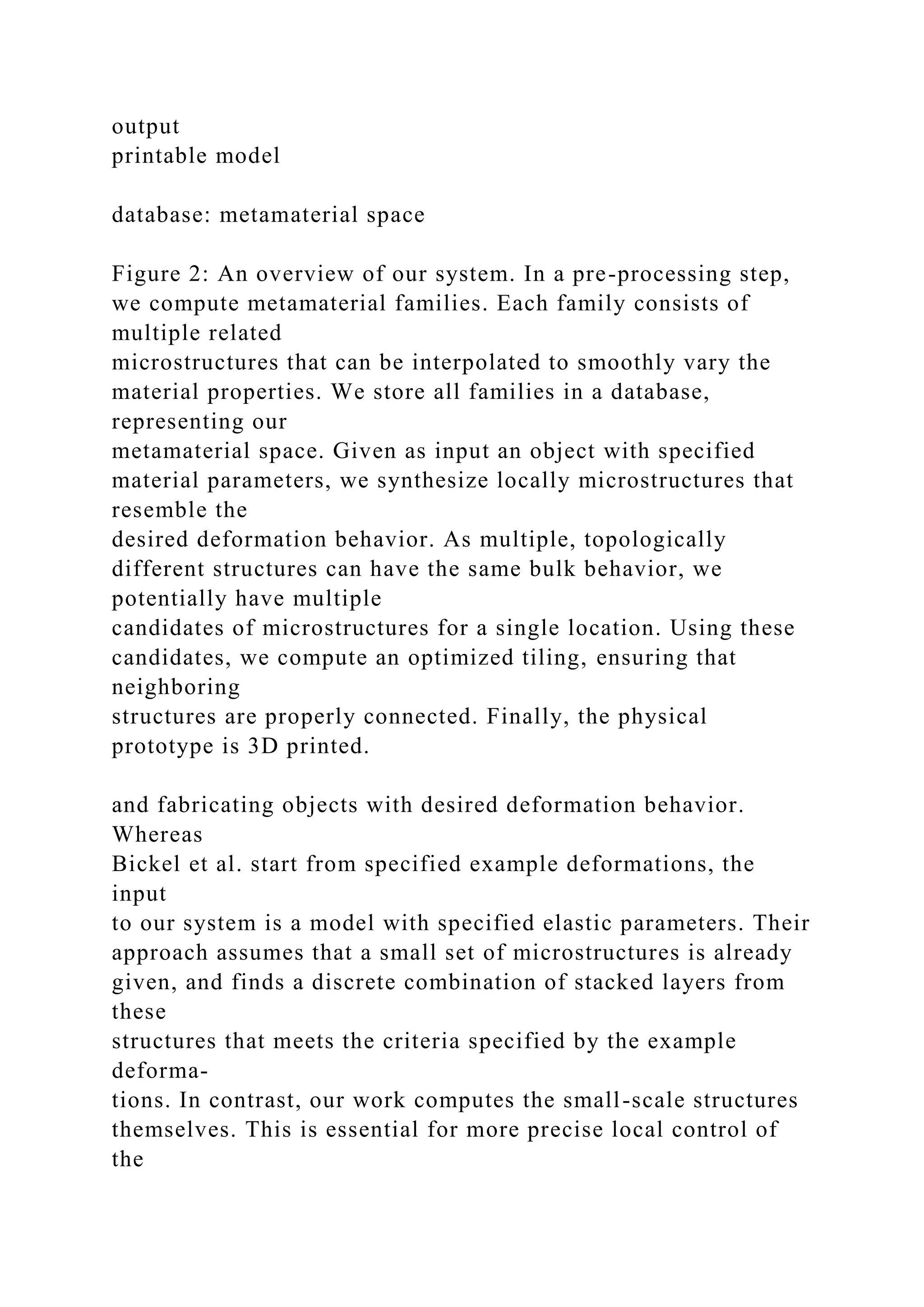
![deformation. Furthermore, Bickel et al. select a material for
each
layer using a branch-and-bound discrete optimization operating
on
the exponential space of designs, requiring running times on the
order of an hour for examples with five layers and nine base
materi-
als. By contrast, our method synthesizes the desired structures
from
pre-computed continuous material subspaces, and is able to
handle
objects with thousands of layers or cells within seconds.
Several previous methods investigate fitting spatially varying
ma-
terial parameters either from measurements of real-world ob-
jects [Becker and Teschner 2007], infer them from user-
specified
input such as example deformation [Skouras et al. 2013], or op-
timize material distributions to achieve higher-level
functionality
such as locomotion of soft robots [Hiller and Lipson 2012]. Re-
cently, Xu et al. [2015] presented an interactive material design
tool, which computes a spatial distribution of material
properties
given user-provided displacements and forces at a set of mesh
ver-
tices. Our method complements these approaches, working
towards
the goal of automatically converting the virtual representation
ob-
tained by those methods into 3D printable objects.
3 Overview
The goal of our system is to automatically convert an object](https://image.slidesharecdn.com/acmreferenceformatschumacherc-221014034045-09a470de/75/ACM-Reference-FormatSchumacher-C-Bickel-B-Rys-J-Mar-docx-14-2048.jpg)
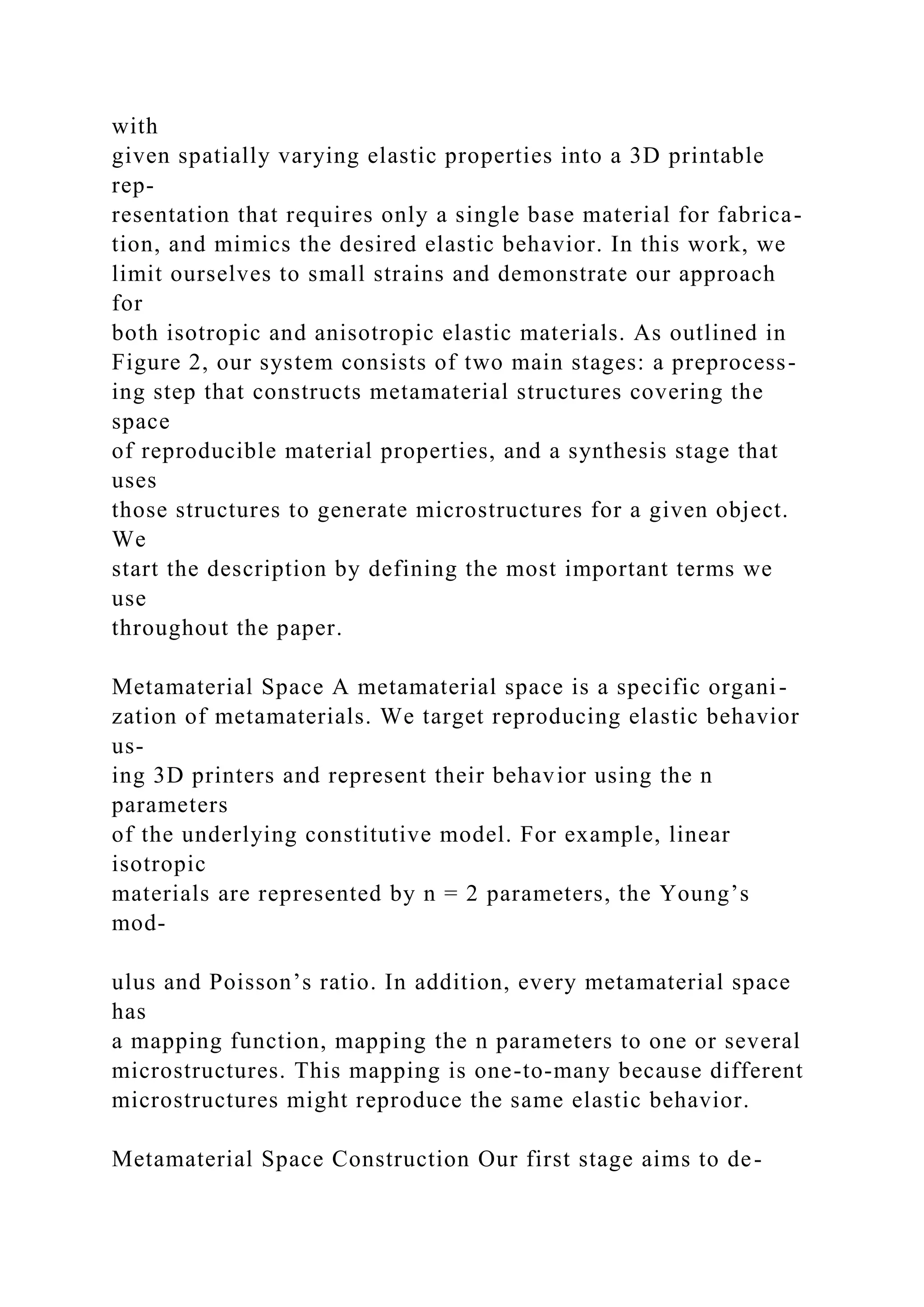
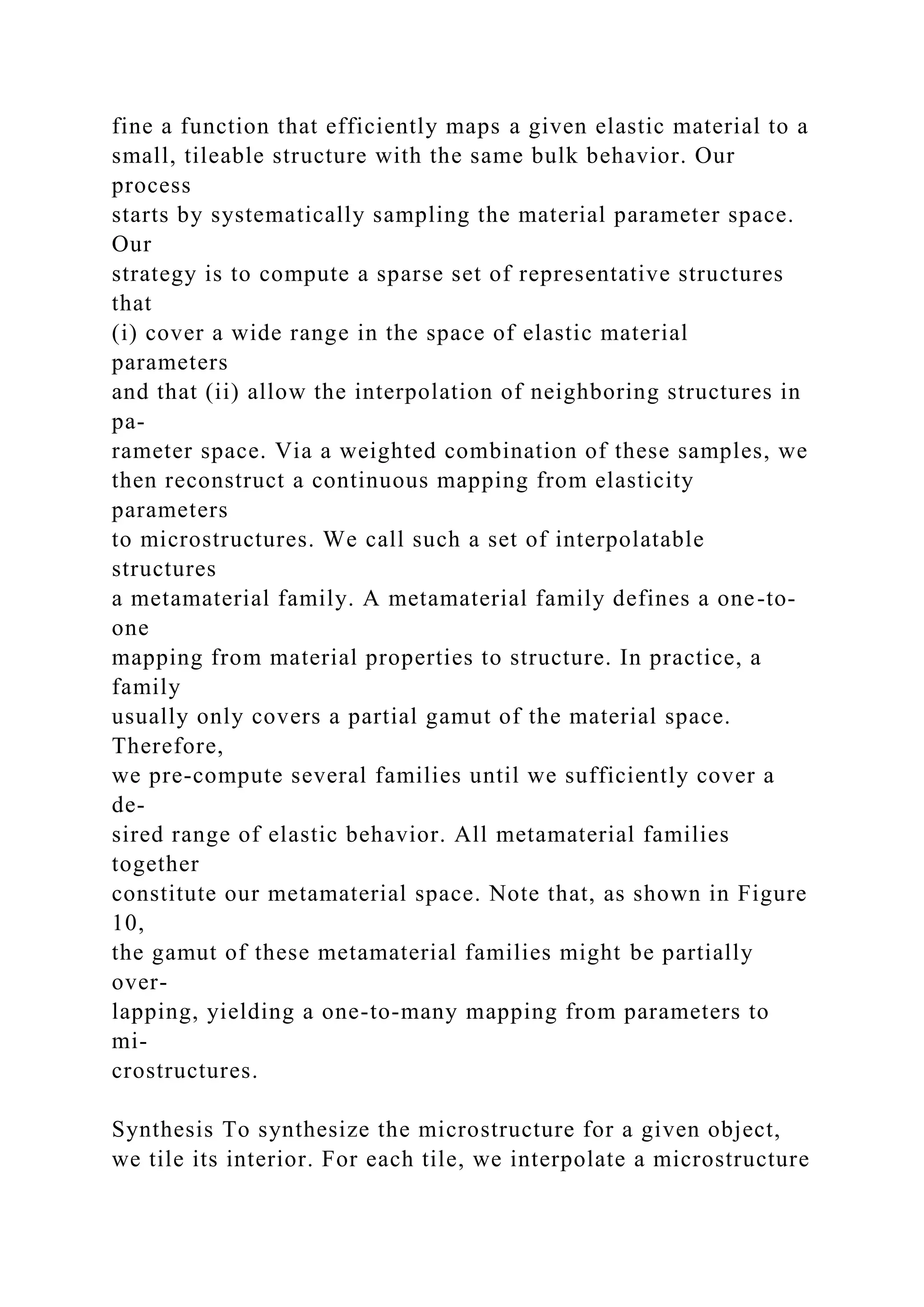


![i=1
(εi : Ci : εi) Vi (2)
for a model with k elements and element areas/volumes Vi. The
to-
tal energy of the system also considers external forces and
tractions.
Summarizing surface traction and forces using a general force
field
f acting on vertices, this energy can be expressed as
Utot(x) = Uel(x) −
n∑
i=1
x
T
i fi, (3)
where n is the number of vertices, and vector x =
[
xT1 · · ·xTn
]T
is the concatenation of all vertex position vectors. The
deformed
configuration x corresponding to the static equilibrium can be
com-
puted by minimizing this energy, or equivalently, solving
∇ xUel(x) = f. (4)
Since the elastic energy Uel(x) is invariant to translation and
rota-](https://image.slidesharecdn.com/acmreferenceformatschumacherc-221014034045-09a470de/75/ACM-Reference-FormatSchumacher-C-Bickel-B-Rys-J-Mar-docx-19-2048.jpg)
![tion, the solution to this problem is not unique. A common
work-
around to this is to constrain enough degrees of freedom to get
rid
of this nullspace. However, the choice of degrees of freedom
might
influence the solution in the presence of forces. Instead, we opt
to
resolve the ambiguities by introducing constraints on the
moments
of the object, similar to Zhou et al. [2013]. These constraints
take
the form
c1(x) =
n∑
i=1
(xi −Xi) = 0
c2(x) =
n∑
i=1
((xi −Xi) × (xi −X)) = 0,
(5)
where Xi is the rest state position of vertex i, and X is the mean
rest state position. For simplicity, we combine these constraints
into a single vector c(x) = [c1(x)T c2(x)T ]T . Intuitively, these
constraints fix the mean translation and rotation. To compute c2
in
the 2D case, we treat positions as points on the z = 0 plane and
use](https://image.slidesharecdn.com/acmreferenceformatschumacherc-221014034045-09a470de/75/ACM-Reference-FormatSchumacher-C-Bickel-B-Rys-J-Mar-docx-20-2048.jpg)
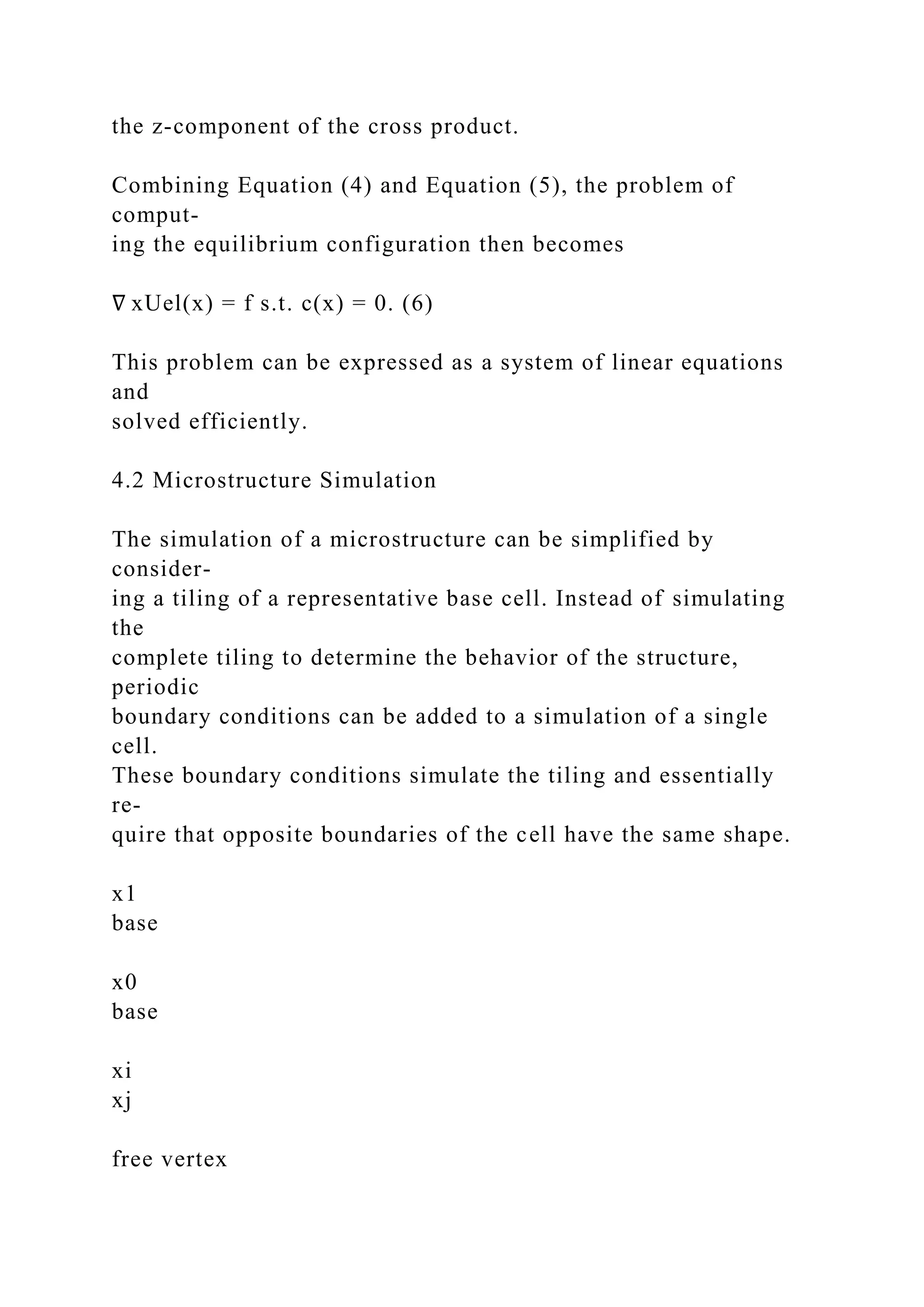
![constrained vertex
Specifically, we assume that any vertex
on a boundary has a matching vertex on
the opposite boundary such that its rela-
tive position on the boundary is identical.
Choosing an arbitrary pair of boundary
vertices xbase0 and x
base
1 as base vertices
then defines the distance between two op-
posite boundaries, and any other vertex
xj on one boundary can be expressed as
a combination of the base vertices and the
corresponding vertex xi on the opposite
boundary [Smit et al. 1998]
xj = x
base
1 + xi −x
base
0 . (7)
These boundary conditions can be efficiently integrated into a
sim-
ulation by removing the corresponding vertices from the degrees
of
freedom.
4.3 Numerical Coarsening
Optimizing a microstructure is an inverse problem,
corresponding](https://image.slidesharecdn.com/acmreferenceformatschumacherc-221014034045-09a470de/75/ACM-Reference-FormatSchumacher-C-Bickel-B-Rys-J-Mar-docx-22-2048.jpg)
![to the forward problem of determining the coarse-scale behavior
from the microstructure. This forward problem can be defined
us-
ing the idea of homogenization: compute a material stiffness
tensor
for a homogeneous material whose elastic behavior matches that
of the tiled microstructure. We use the Numerical Coarsening
ap-
proach [Kharevych et al. 2009], which uses a set of load cases
to
approximate the coarse elastic behavior of a given structure.
Essen-
tially, given the deformations h that these load cases induce,
which
are called harmonic displacements, the method computes a
single
material stiffness tensor C(h) that describes the homogenized
ma-
terial behavior of a microstructure, which we will use to solve
the
inverse problem. We refer to the supplemental material for a de-
tailed introduction to the Numerical Coarsening approach.
5 Microstructure Optimization
Our microstructure optimization method solves the inverse
problem
to the Numerical Coarsening method mentioned in the previous
sec-
tion, solving for a microstructure that coarsens to a given
stiffness
tensor.
Optimizing a microstructure requires a way to define and alter
the
material distribution within a cell. A common approach in](https://image.slidesharecdn.com/acmreferenceformatschumacherc-221014034045-09a470de/75/ACM-Reference-FormatSchumacher-C-Bickel-B-Rys-J-Mar-docx-23-2048.jpg)
![topology
optimization is to discretize the material distribution by
subdivid-
ing the cell into a grid of material voxels [Sigmund 2009],
where
each voxel is associated with a binary activation that describes
136:4 • C. Schumacher et al.
ACM Transactions on Graphics, Vol. 34, No. 4, Article 136,
Publication Date: August 2015
whether the voxel is full (1) or void (0). However, optimizing
the
microstructure using these binary variables directly would be
in-
feasible for moderately large grids. Instead, the problem is
usually
relaxed by allowing the activations to vary smoothly between 0
and
1 during the optimization, and only requiring them to converge
to
a binary solution at the end of the optimization. For the
continuous
activations, a meaningful interpolation between void and full
voxels
has to be defined such that the activation corresponds to a
physical
quantity in the simulation. A simple way to define this is by
inter-
polating between stiffness tensors. For any voxel i (1 ≤ i ≤ m,
with m being the number of voxels), an individual material
stiffness
tensor Ci is defined as an interpolation between the base](https://image.slidesharecdn.com/acmreferenceformatschumacherc-221014034045-09a470de/75/ACM-Reference-FormatSchumacher-C-Bickel-B-Rys-J-Mar-docx-24-2048.jpg)
![material
stiffness tensor Cbase and air, which is assumed to have a zero
ma-
terial stiffness tensor:
Ci = αiCbase. (8)
To ensure numerical stability, the minimum of αi is set to αmin
=
10−5. This interpolation scheme follows the established SIMP
(solid isotropic material with penalization) approach for an
expo-
nent of 1 [Sigmund 2009]. Choosing a different exponent would
help to converge to a binary solution in topology optimization
prob-
lems with extremal objectives, where adding more material im-
proves the objective and the maximum amount of material is
fixed
by a constraint. However, we do not have such an objective, and
have to resort to other means to reach a binary solution. As a
con-
sequence, the exponent we choose does not influence the
conver-
gence.
The number of activations can be reduced by exploiting
symmetries
of the goal material. For example, for a cubic material, the
response
along each axis has to be identical. Mirroring the activations
along
all axes and all diagonal planes will therefore not constrain the
so-
lution.
5.1 Problem Formulation](https://image.slidesharecdn.com/acmreferenceformatschumacherc-221014034045-09a470de/75/ACM-Reference-FormatSchumacher-C-Bickel-B-Rys-J-Mar-docx-25-2048.jpg)
![We pose the problem of finding a microstructure that exhibits a
large-scale behavior identical to a homogeneous material with
de-
sired material parameters pgoal (see Section 4.1) as a least
squares
problem. From the parameters pgoal, a stiffness tensor Cgoal =
C(pgoal) can be computed. The optimization then modifies the
ac-
tivations α such that the homogenized stiffness tensor C(h(α)),
which is indirectly dependent on the activations through the
har-
monic displacements h(α), matches the goal stiffness tensor as
closely as possible:
min
α
‖Cgoal −C(h(α))‖2F + R
s.t. αmin ≤ αi ≤ 1 1 ≤ i ≤ m.
(9)
Here, R is a combined regularization term that penalizes less
desir-
able results. This formulation differs from most other
microstruc-
ture optimization approaches that typically try to find extremal
properties for a specific amount of material. It is related to the
formulation in [Zhou and Li 2008], though it does not use a
volume
fraction constraint.
5.2 Regularization
While the optimization problem (9) could be solved without any](https://image.slidesharecdn.com/acmreferenceformatschumacherc-221014034045-09a470de/75/ACM-Reference-FormatSchumacher-C-Bickel-B-Rys-J-Mar-docx-26-2048.jpg)

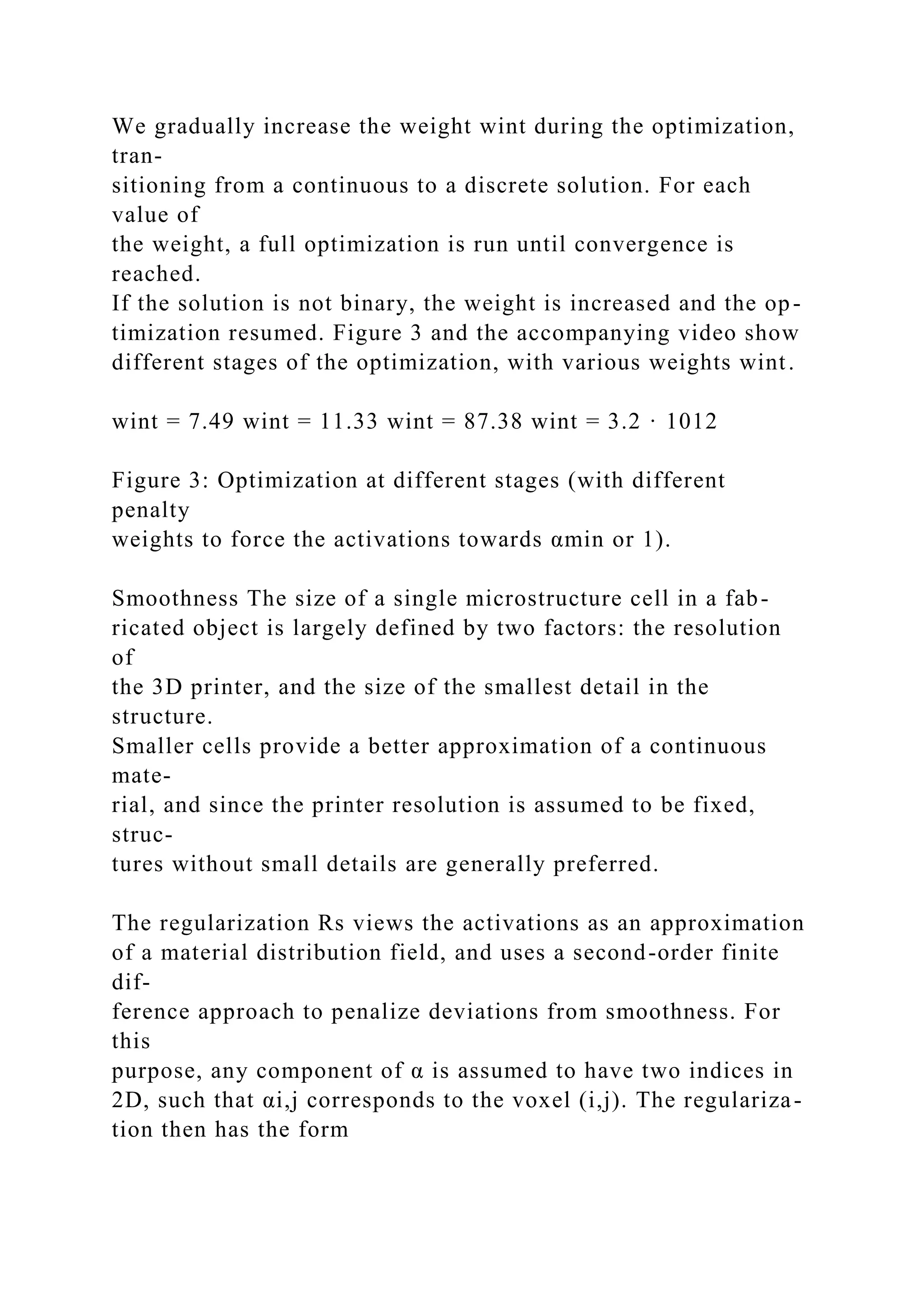

![1998]. To avoid such structures, the regularization Rcb
penalizes
configurations that contain checkerboard patterns, as illustrated
in
Figure 4. In 2D, this regularization is based on 2 × 2 patches of
voxels and has the form
Rcb =
∑
i,j
(1 −αi,j )(αi+1,j −αmin)
(αi,j+1 −αmin)(1 −αi+1,j+1)
+(αi,j −αmin)(1 −αi+1,j )
(1 −αi,j+1)(αi+1,j+1 −αmin).
(13)
In the case of binary activations, Rcb is only non-zero if the
struc-
ture contains a checkerboard pattern. In the continuous case, the
regularization also acts as an additional regularizer that pushes
the
activations towards αmin or 1.
In 3D, the number of different local checkerboard patterns in-
creases. The corresponding formula can be found in the supple-
mental document.
Regularization Weights The performance of our microstructure
optimization depends on the choice of weights, and how they
are
updated during the optimization. For the optimization in 2D, we
start with w0int = 0, w](https://image.slidesharecdn.com/acmreferenceformatschumacherc-221014034045-09a470de/75/ACM-Reference-FormatSchumacher-C-Bickel-B-Rys-J-Mar-docx-30-2048.jpg)
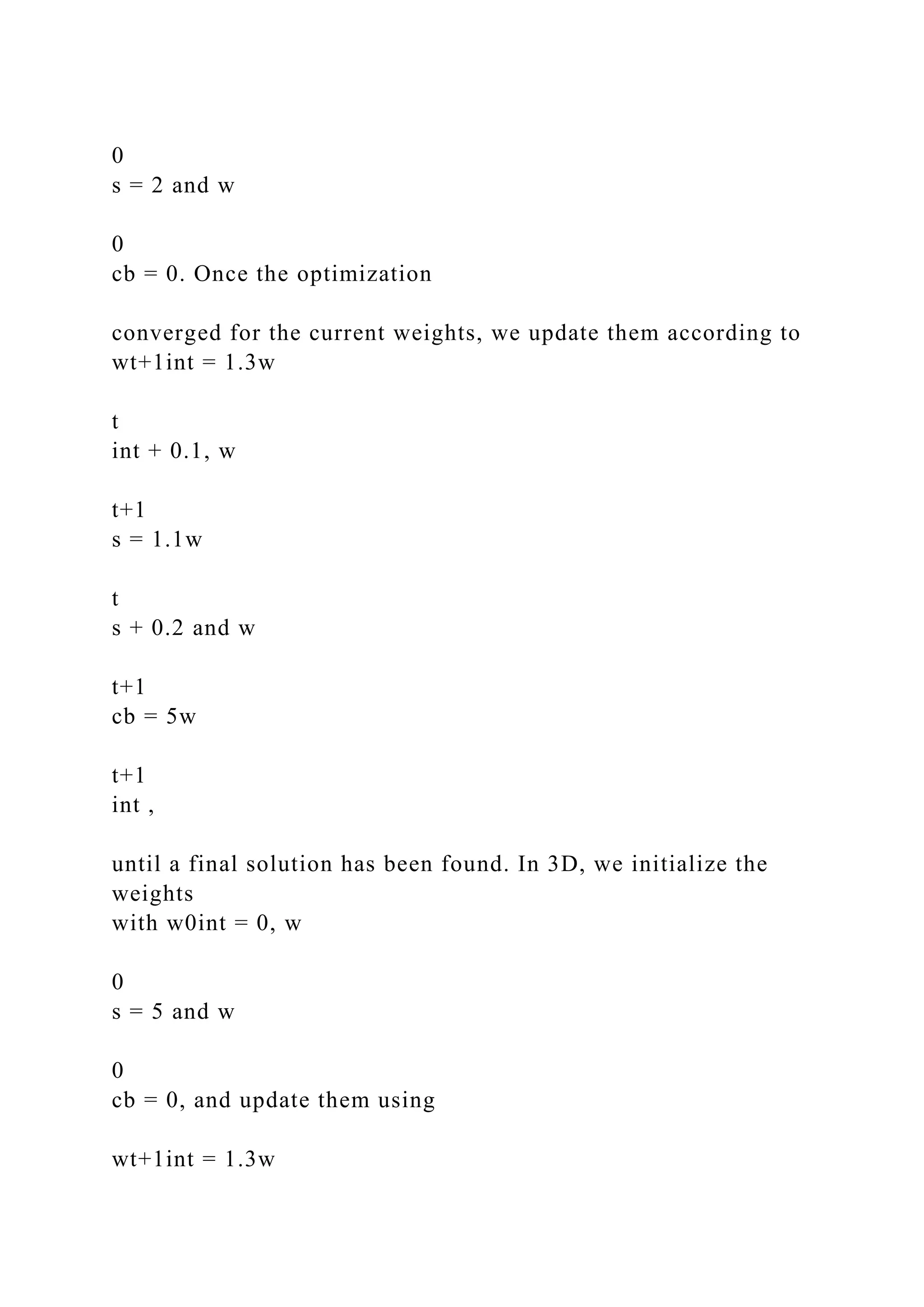
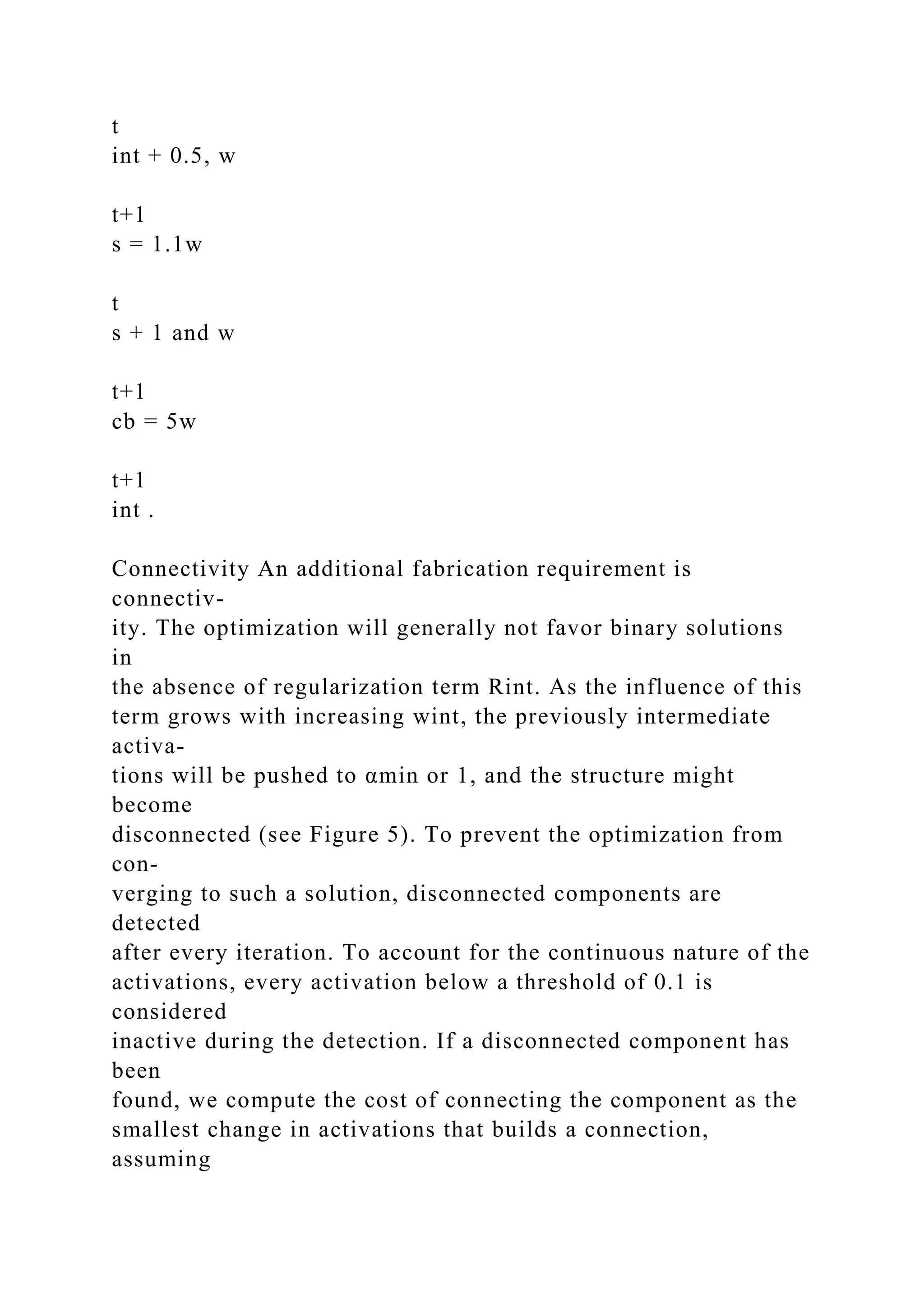
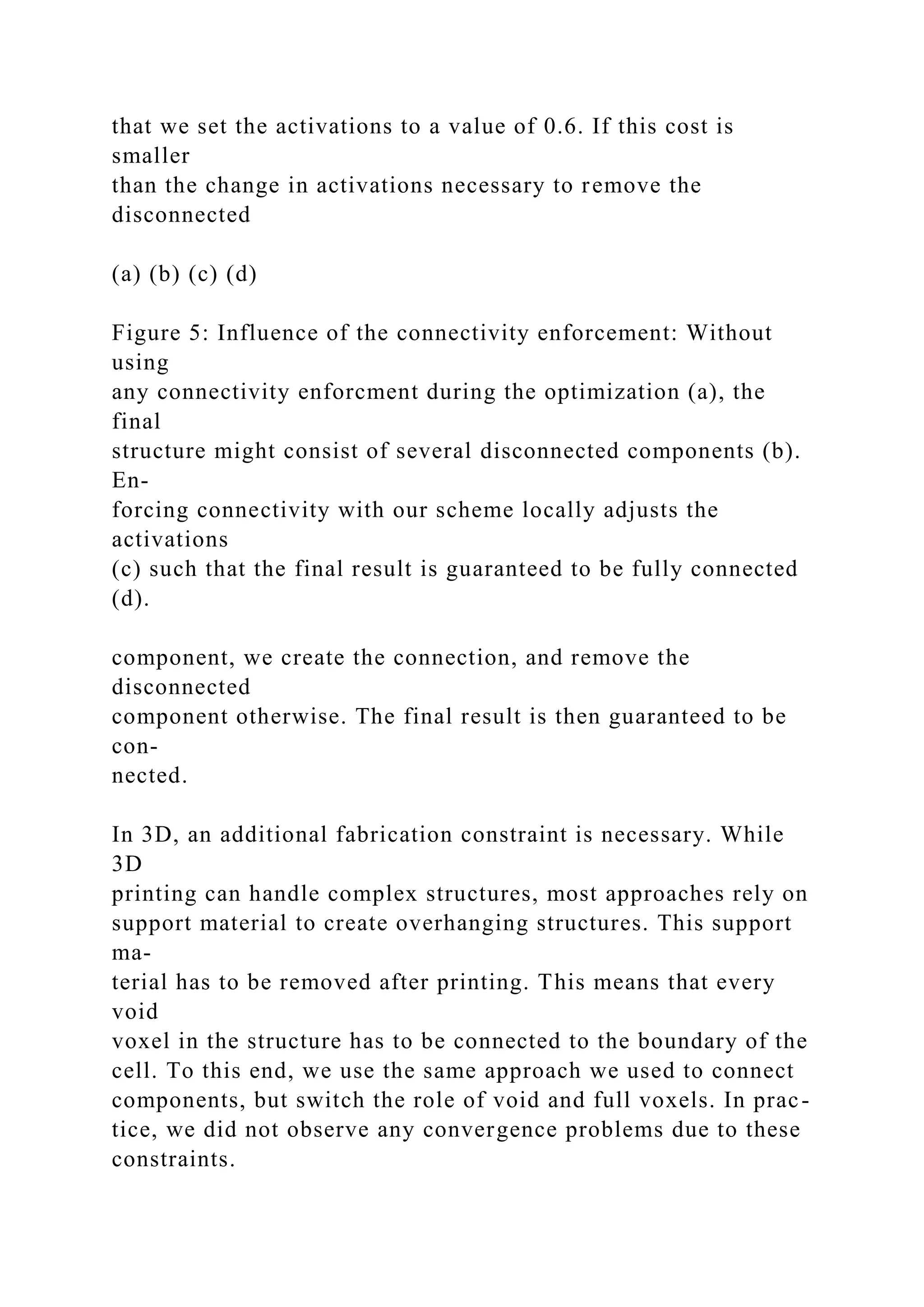
![5.3 Numerical Methods
The optimization problem (9) is solved with L-BFGS-B [Byrd
et al. 1995], which enforces the boundary constraints. Addition-
ally, the indirect relationship between the coarsened stiffness
tensor
C(h(α)) and the activations α through Numerical Coarsening has
to be taken into account when computing the gradient of the ob-
jective. We refer to the supplemental document for details on
this
computation.
6 Metamaterial Spaces
The optimization method from the previous section is able to
pro-
duce microstructures for a variety of material parameters, but
may
take a long time to generate a desired structure. Moreover, if the
de-
sired object contains spatially varying parameters, several
optimiza-
tions need to be performed to generate the required
microstructures,
making this approach infeasible in practice. To avoid this
problem,
we use a data-driven approach to assemble a structure with a de-
sired behavior by interpolation from a pre-computed
metamaterial
family.
A metamaterial family is a collection of microstructures, each
labeled with its corresponding coarse-scale material parameters,
which are a point in the space of possible material properties
(pa-](https://image.slidesharecdn.com/acmreferenceformatschumacherc-221014034045-09a470de/75/ACM-Reference-FormatSchumacher-C-Bickel-B-Rys-J-Mar-docx-34-2048.jpg)
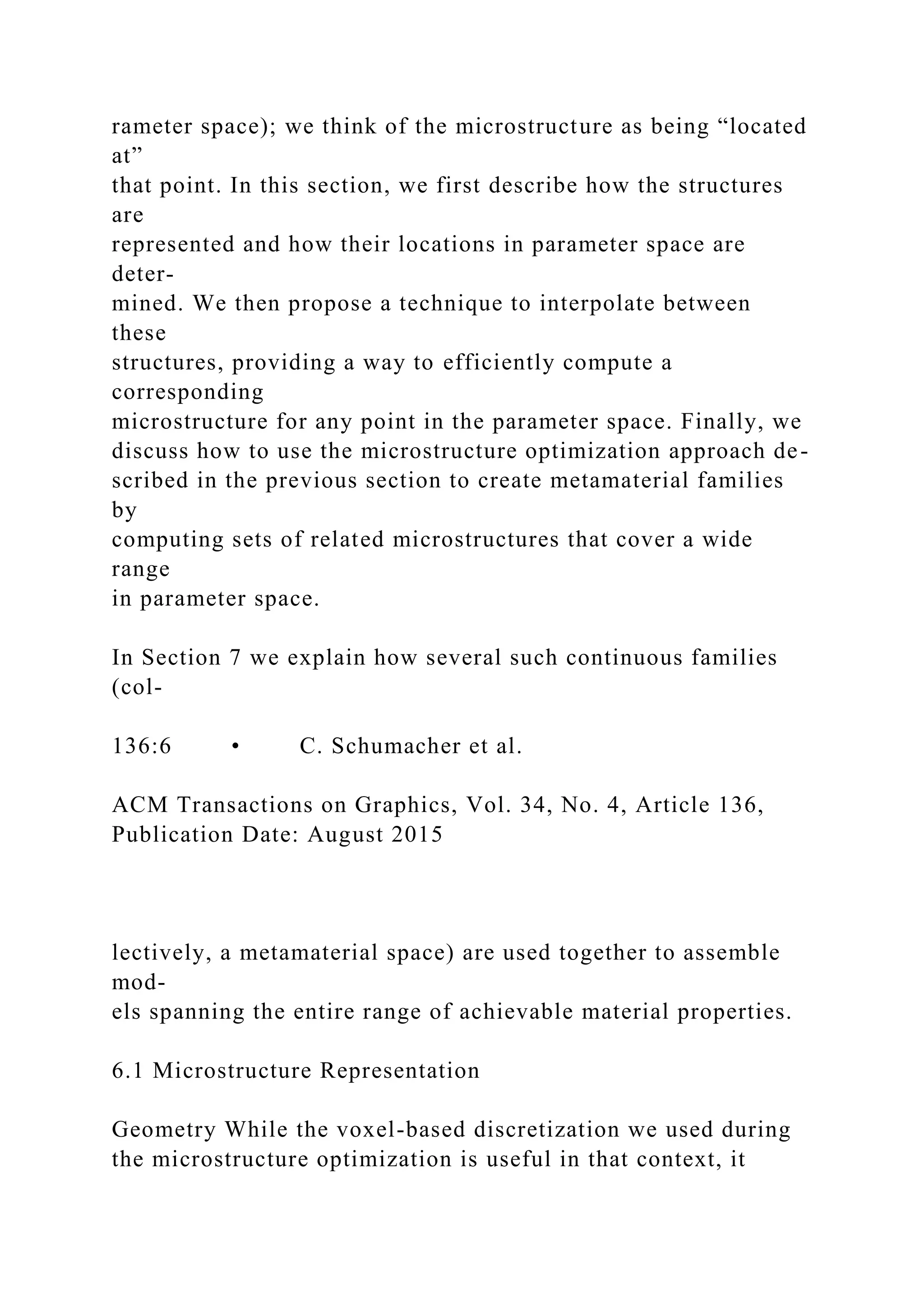
![poses
two problems for the construction of a metamaterial space: (i)
The
changes to the structure are all discrete in nature, so the
resulting
interpolation cannot be continuous, and (ii) the resulting
geometry
can contain stair structures. These sharp corners can lead to lo-
calized stresses under deformation and the structure would
fracture
more easily.
Instead of using voxels, we use signed L2-distance fields in [0,
1]d
to represent structures in a metamaterial space, which allows for
a
smooth interpolation. Additionally, we perform a Gaussian
smooth-
ing step every time we sample a microstructure from the
metama-
terial space, which removes unwanted discretization artifacts
(Fig-
ure 6). To increase resolution, we scale the grid resolution by a
factor of 2 and 3 compared to the original voxelization, in 2D
and
3D, respectively.
Material Parameters Numerical Coarsening is used to compute
a stiffness tensor that describes the behavior of a particular mi-
crostructure. However, for sampling and interpolation we would
like to use a parameter space with fewer degrees of freedom
than
this tensor has (6 in two dimensions, 21 in three dimensions).
By
considering only isotropic, cubic or orthotropic materials, the](https://image.slidesharecdn.com/acmreferenceformatschumacherc-221014034045-09a470de/75/ACM-Reference-FormatSchumacher-C-Bickel-B-Rys-J-Mar-docx-36-2048.jpg)
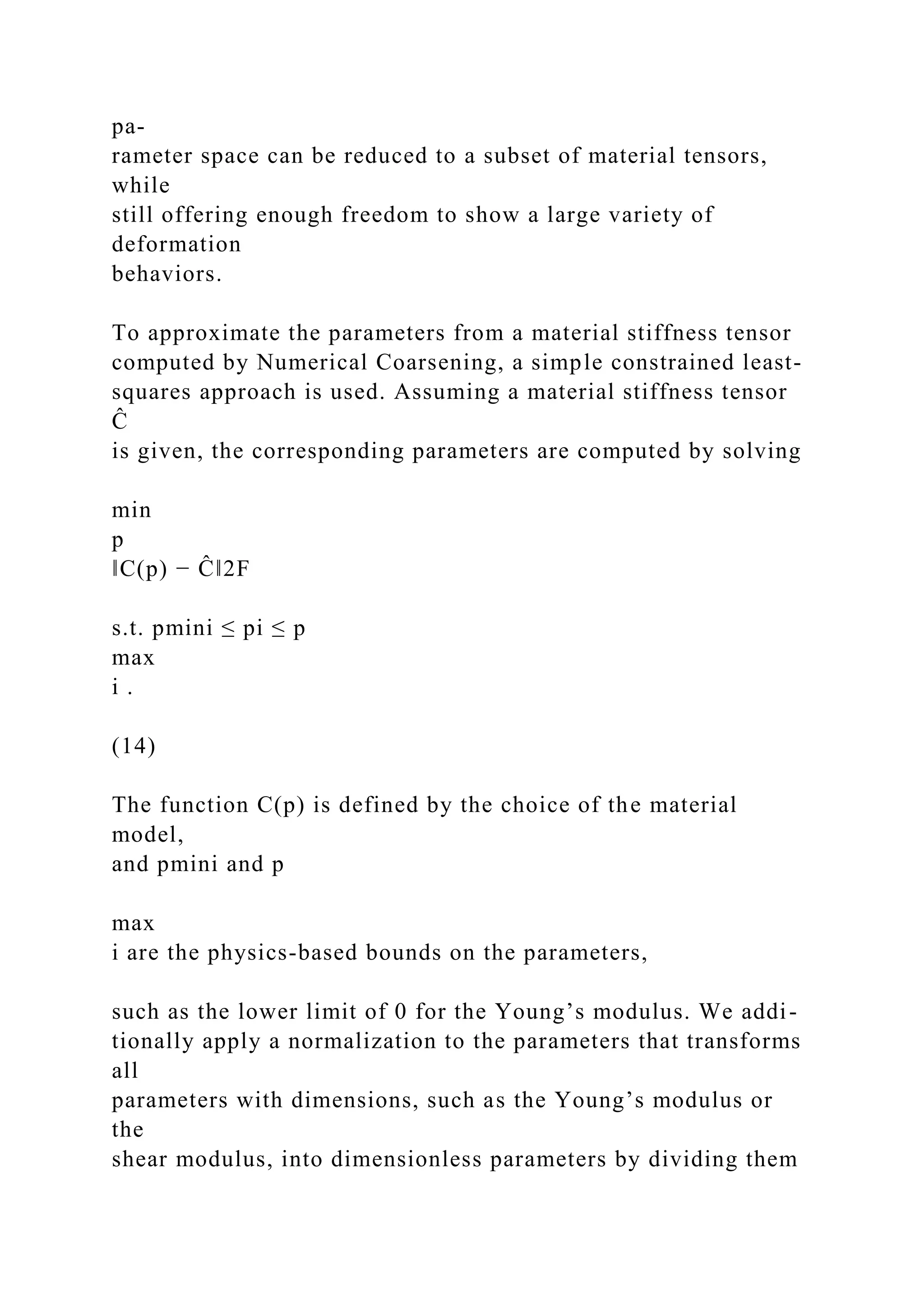
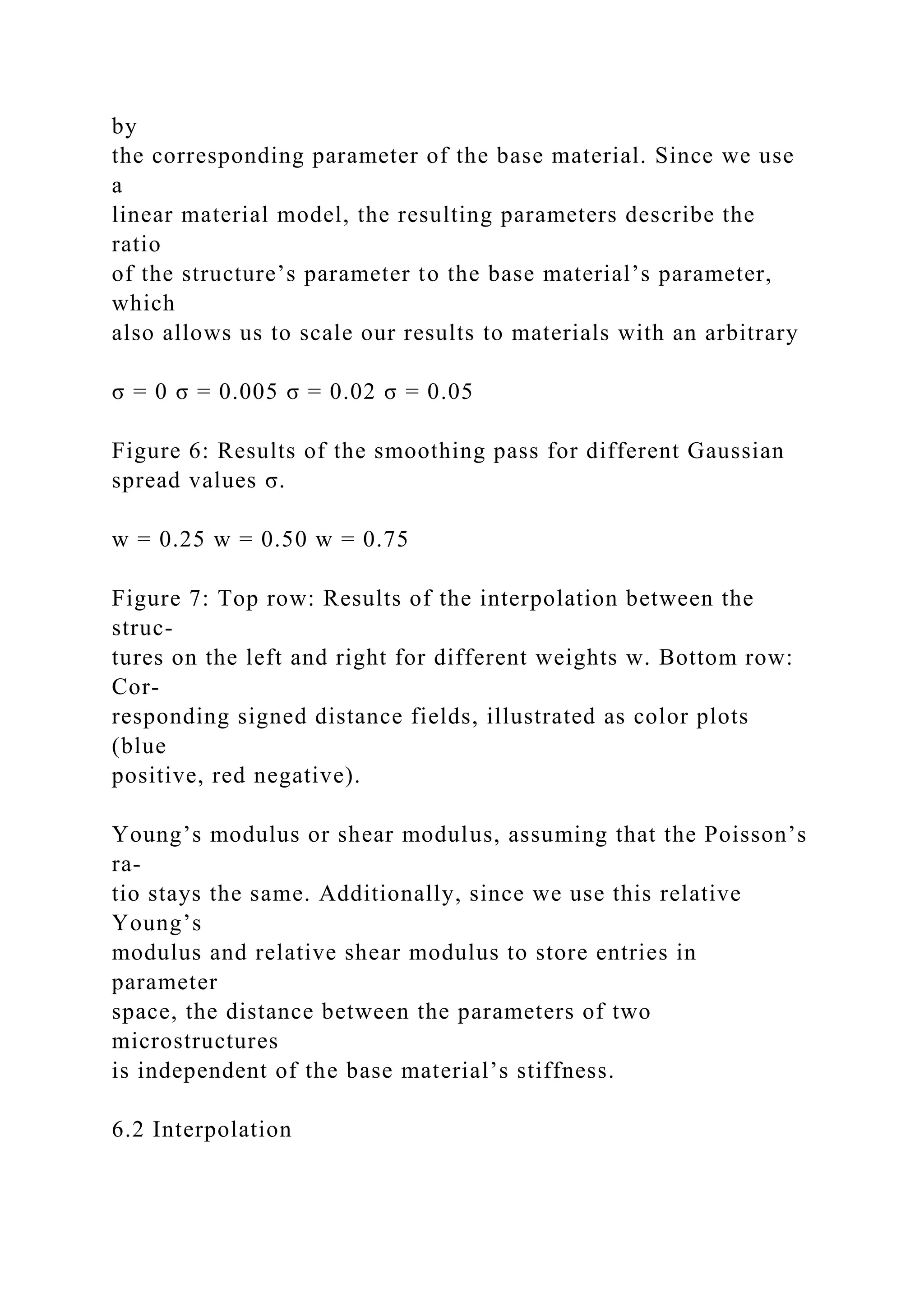
![The microstructures in our database describe metamaterials with
certain properties; each gives a point sample of the mapping
from
material parameters to microstructures. Figure 13, 10, and 12 il-
lustrate data points for various metamaterial families. To
generate
a structure for an arbitrary given set of parameters, we
interpolate
between points of a family, forming a weighted average over a
set
of microstructures with similar elastic properties. We first com-
pute weights based on the inverse distance between the input
pa-
rameters and the parameters of the metamaterial space samples,
us-
ing the Wendland function with compact support [Nealen 2004].
We chose the parameter of the Wendland function such that the
weights vanish beyond a given interpolation radius, which is set
to 0.1 in normalized coordinates, or the distance to the (M + 1)-
nearest neighbor (M being the number of material parameters),
whichever is larger. Before we interpolate, we apply the
transfor-
mation f(x) = sgn(x) log(|x|+ δ) to transform the distance fields
to log space, and add a small constant δ = 10−3 to keep values
near
the surface. In practice, we found that interpolation in log space
re-
duces artifacts due to topology changes, e.g., holes appearing or
disappearing. Given the weights and transformed distance
fields,
we then compute the interpolated structure by linearly
interpolating
the transformed distance fields. Figure 7 illustrates the
interpolation
process.](https://image.slidesharecdn.com/acmreferenceformatschumacherc-221014034045-09a470de/75/ACM-Reference-FormatSchumacher-C-Bickel-B-Rys-J-Mar-docx-39-2048.jpg)
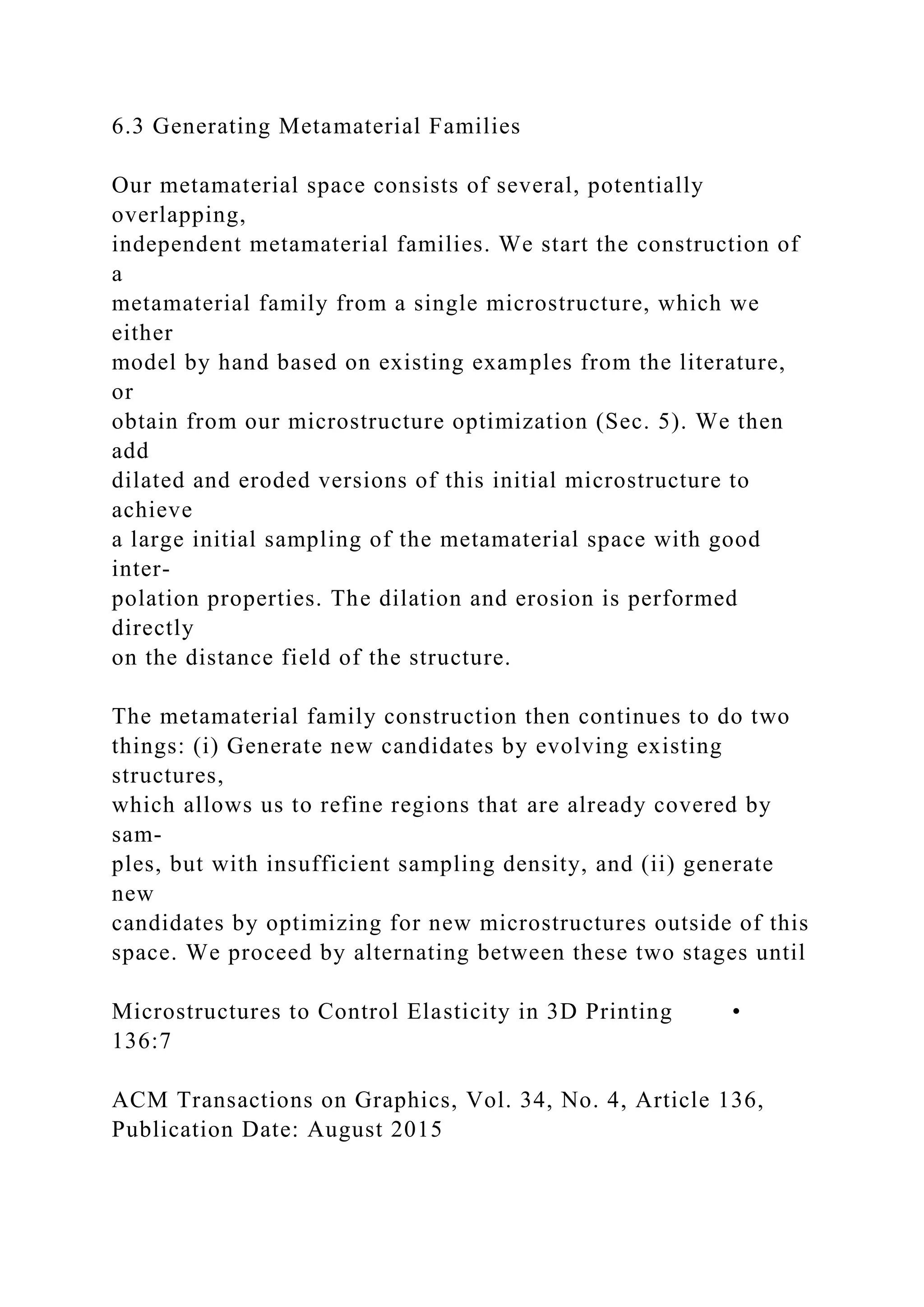

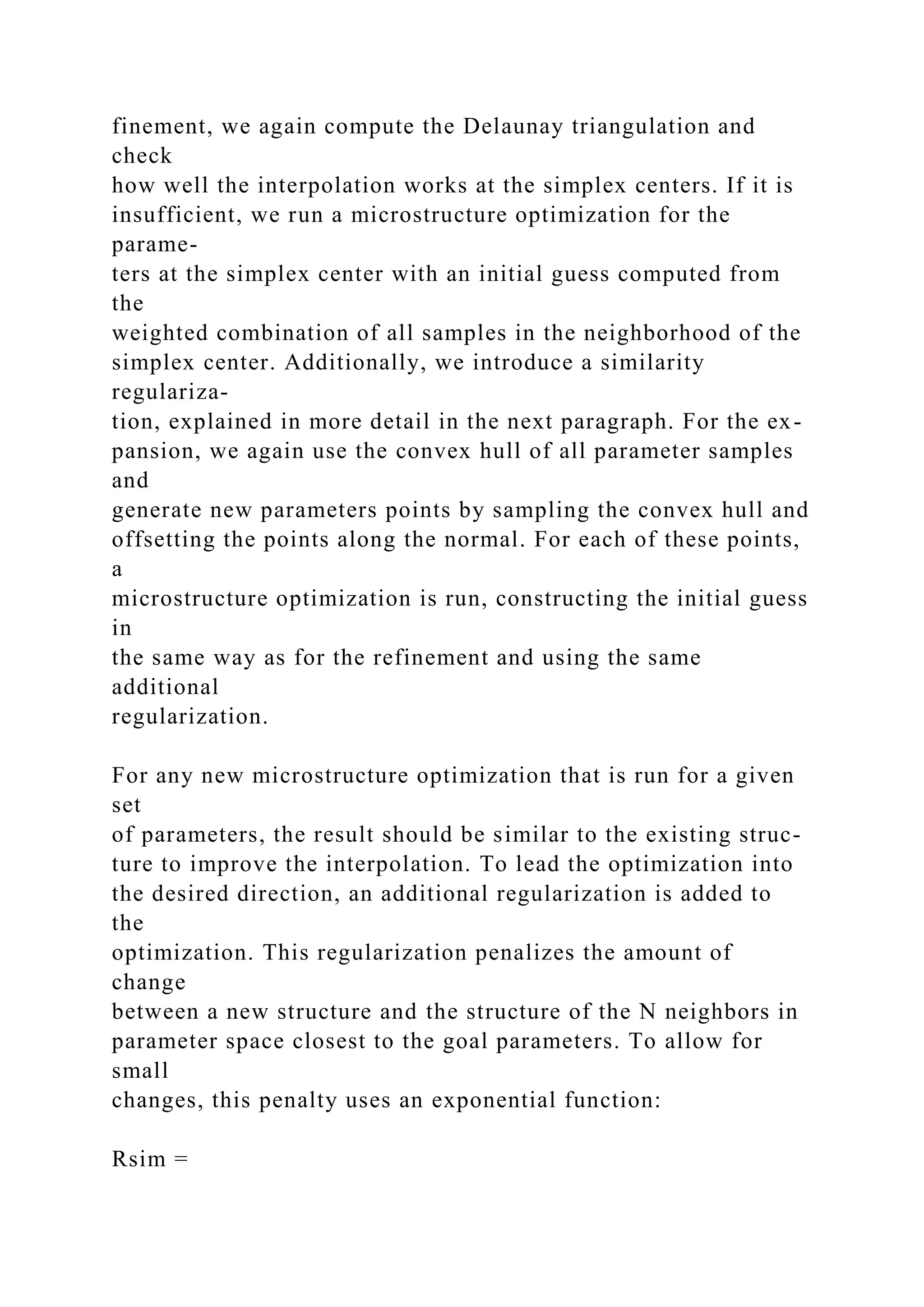
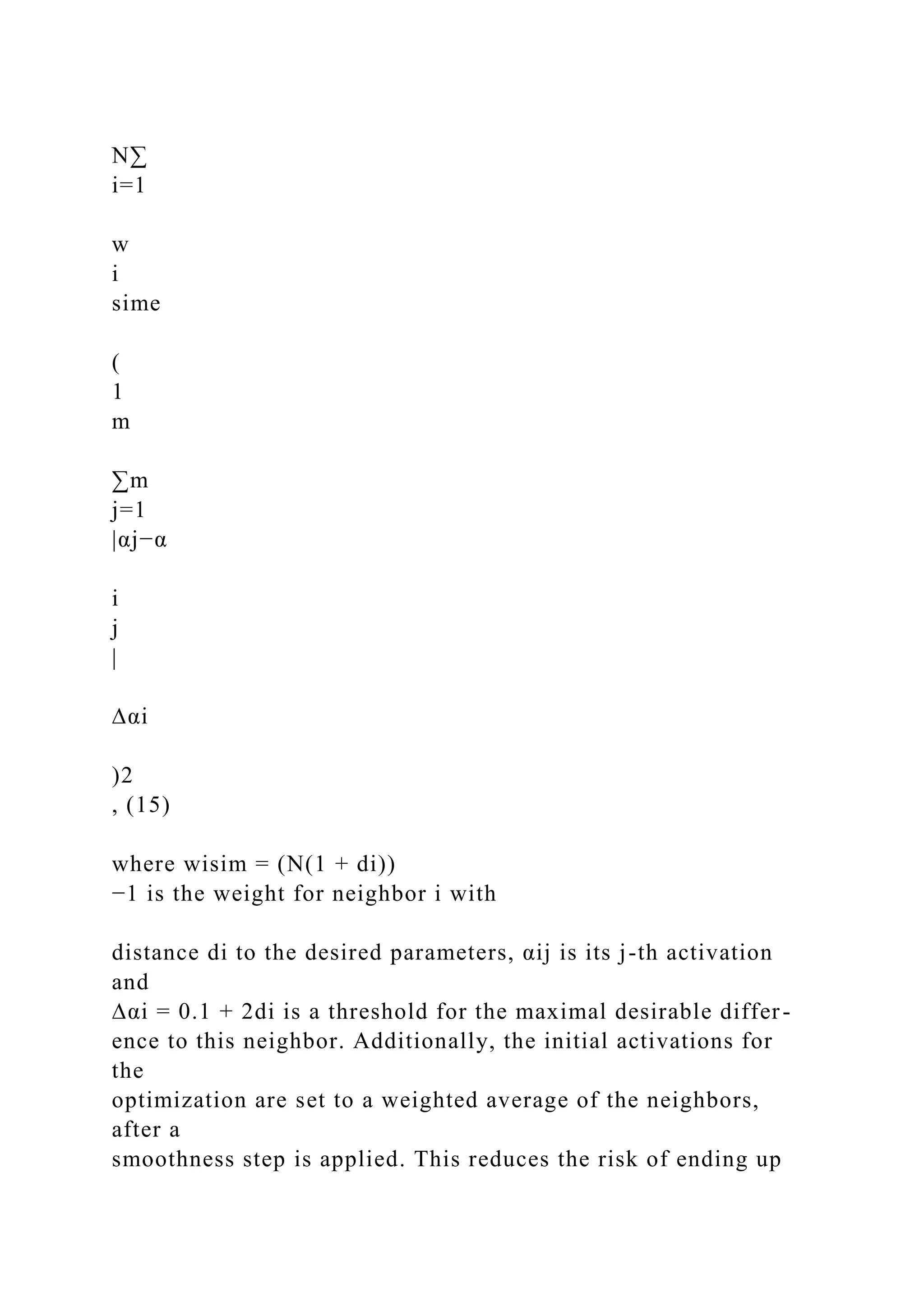
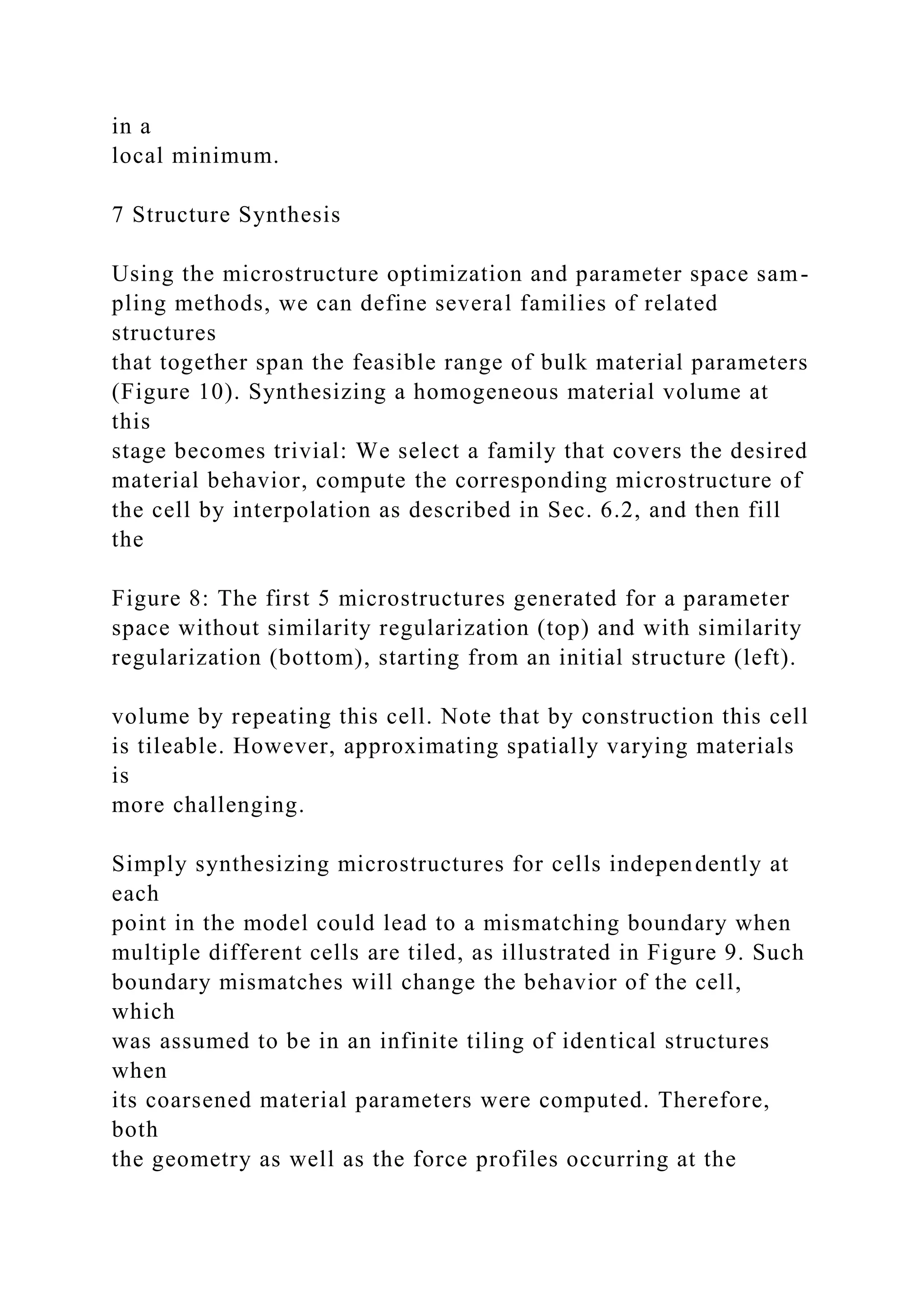
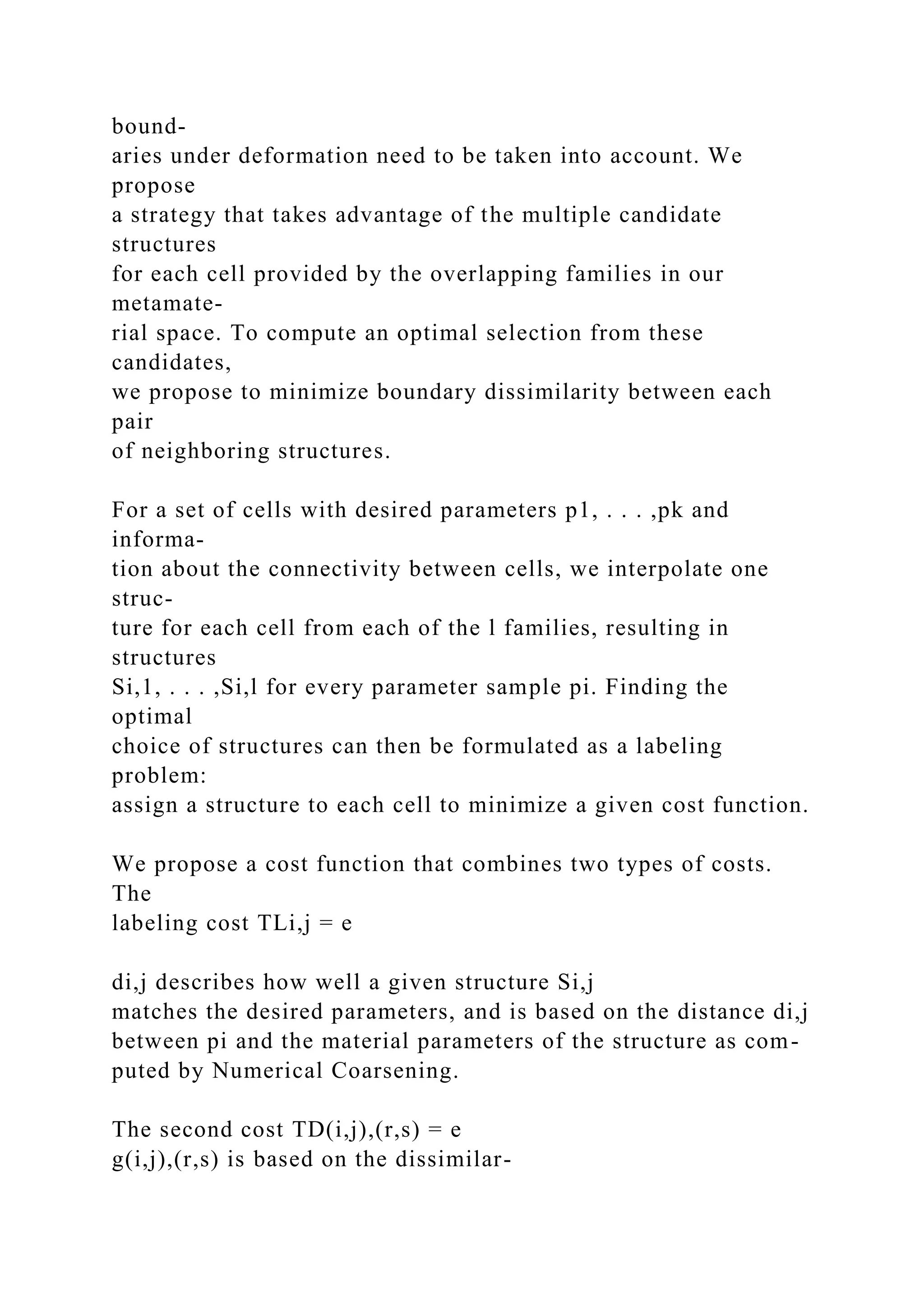
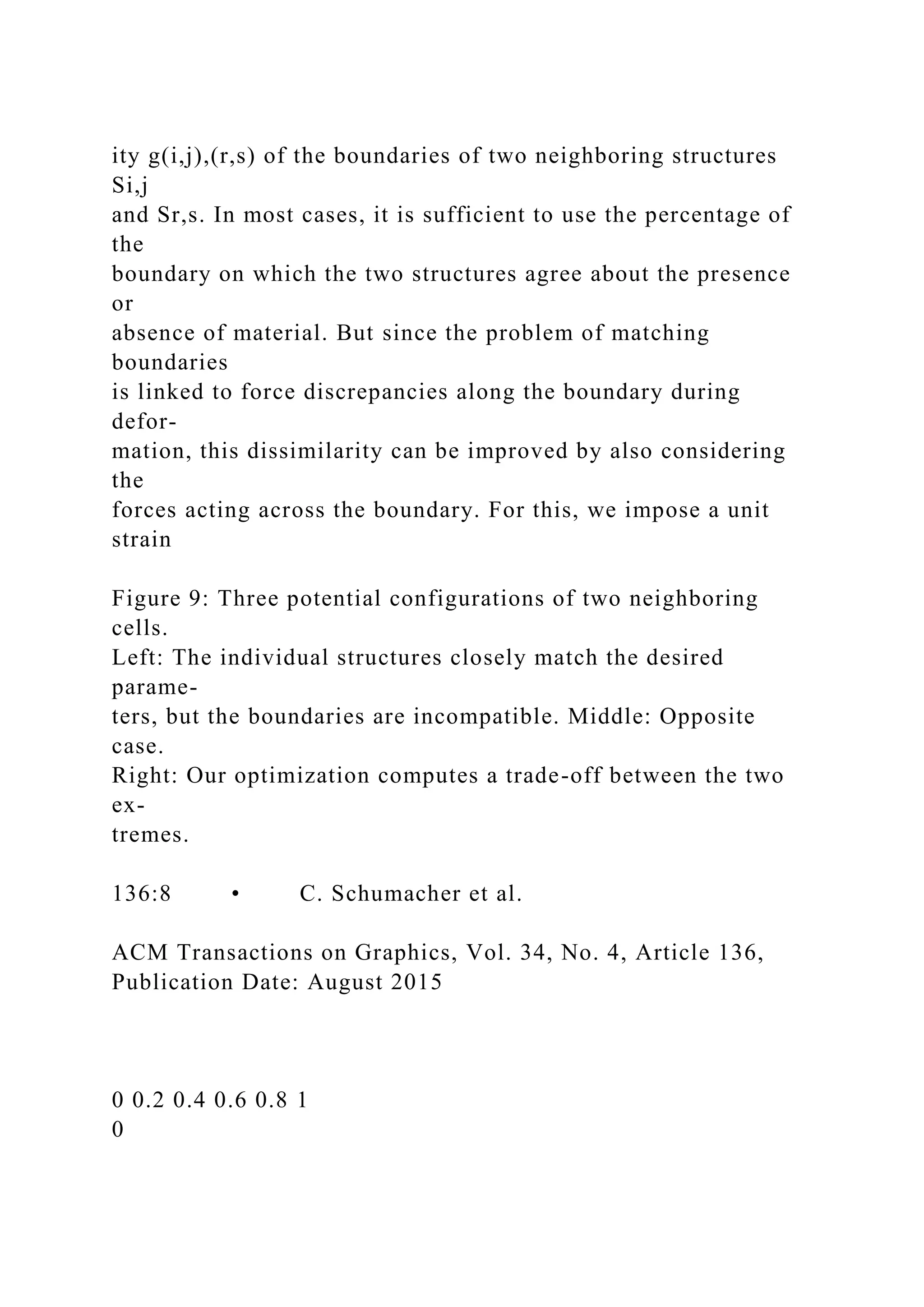
![0.1
0.2
0.3
0.4
0.5
0.6
0.7
0.8
0.9
1
Relative Young’s modulus [−]
Po
is
so
n
’s
ra
ti
o
[−
]](https://image.slidesharecdn.com/acmreferenceformatschumacherc-221014034045-09a470de/75/ACM-Reference-FormatSchumacher-C-Bickel-B-Rys-J-Mar-docx-47-2048.jpg)
![Figure 10: Data points for five different metamaterial families
for a
cubic material in 2D. The values for the shear modulus are
omitted.
on the boundary of each cell, such that they are stretched
perpen-
dicular to the boundary between the two cells. We then integrate
the
force magnitude as well as the force difference magnitude over
the
boundary, and set the dissimilarity g(i,j),(r,s) to the ratio of
force
difference magnitude to mean force magnitude. We compare the
two approaches to compute the boundary dissimilarity in Sec.
8.2.
Finding the globally optimal solution to this optimization
problem
is NP-hard. However, efficient algorithms exist that can find an
approximate solution. We employ an iterative method using
mes-
sage passing based on the alternating direction method of
multipli-
ers (ADMM) as described in Derbinsky et al. [2013].
For the resulting structures, the distance fields can then be com-
bined. To improve connectivity between cells, the smoothing
pass
is performed on the combined distance field instead of each cell
in-
dividually. The final structure is reconstructed from the
combined
distance field using marching cubes.](https://image.slidesharecdn.com/acmreferenceformatschumacherc-221014034045-09a470de/75/ACM-Reference-FormatSchumacher-C-Bickel-B-Rys-J-Mar-docx-48-2048.jpg)
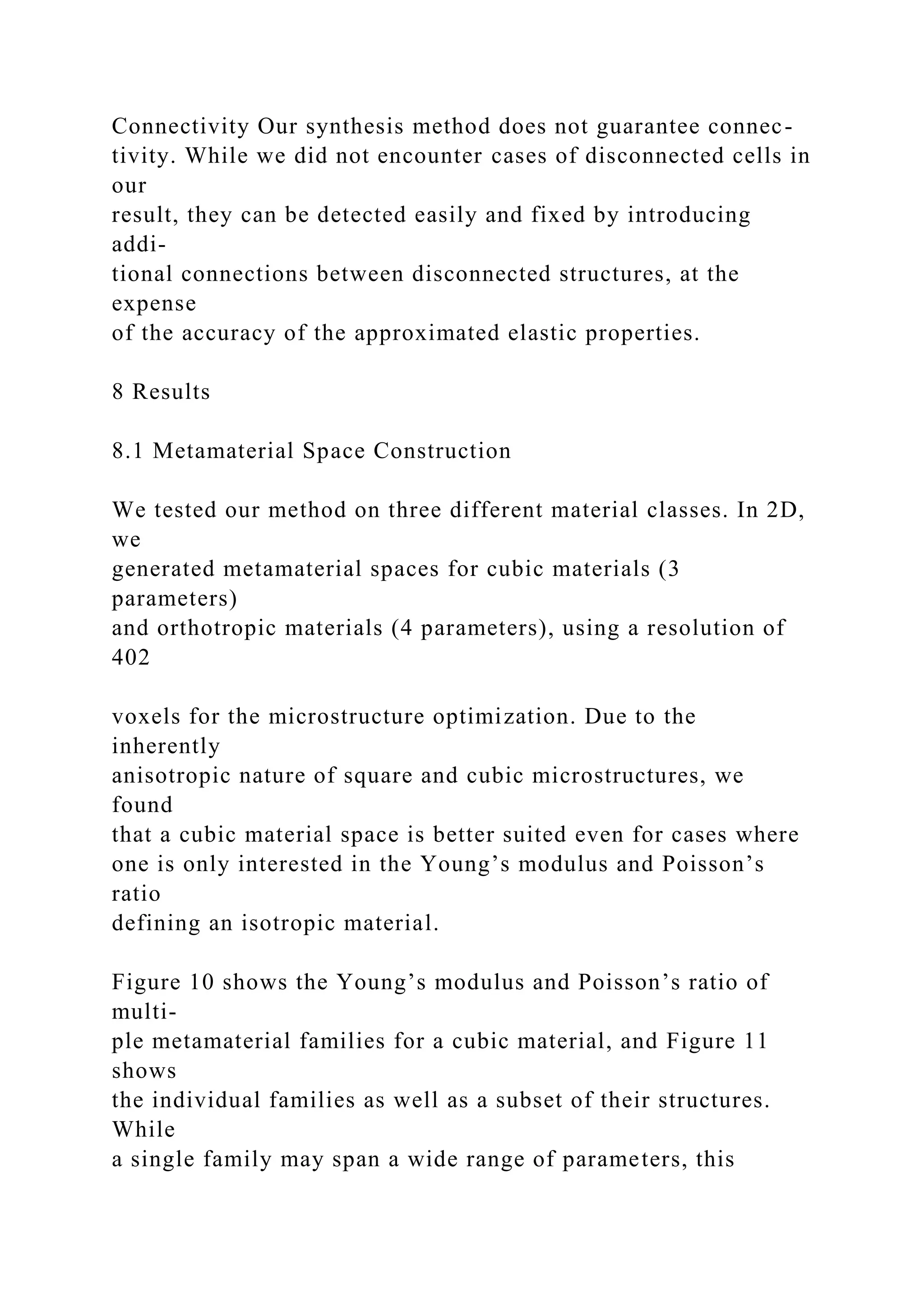
![example
shows that combining multiple families can significantly expand
this range. Figure 12 shows the orthotropic metamaterial
families,
projected into four different combinations of the parameter
axes.
We also used our method to compute a metamaterial space for
cubic
0 0.2 0.4 0.6 0.8 1
0
0.1
0.2
0.3
0.4
0.5
0.6
0.7
0.8
0.9
1
Relative Young’s modulus [−]
Po](https://image.slidesharecdn.com/acmreferenceformatschumacherc-221014034045-09a470de/75/ACM-Reference-FormatSchumacher-C-Bickel-B-Rys-J-Mar-docx-50-2048.jpg)
![is
so
n
’s
ra
ti
o
[−
]
0 0.2 0.4 0.6 0.8 1
0
0.1
0.2
0.3
0.4
0.5
0.6
0.7
0.8
0.9
1](https://image.slidesharecdn.com/acmreferenceformatschumacherc-221014034045-09a470de/75/ACM-Reference-FormatSchumacher-C-Bickel-B-Rys-J-Mar-docx-51-2048.jpg)
![Relative Young’s modulus [−]
Po
is
so
n
’s
ra
ti
o
[−
]
0 0.2 0.4 0.6 0.8 1
0
0.1
0.2
0.3
0.4
0.5
0.6
0.7
0.8](https://image.slidesharecdn.com/acmreferenceformatschumacherc-221014034045-09a470de/75/ACM-Reference-FormatSchumacher-C-Bickel-B-Rys-J-Mar-docx-52-2048.jpg)
![0.9
1
Relative Young’s modulus [−]
Po
is
so
n
’s
ra
ti
o
[−
]
0 0.2 0.4 0.6 0.8 1
0
0.1
0.2
0.3
0.4
0.5
0.6](https://image.slidesharecdn.com/acmreferenceformatschumacherc-221014034045-09a470de/75/ACM-Reference-FormatSchumacher-C-Bickel-B-Rys-J-Mar-docx-53-2048.jpg)
![0.7
0.8
0.9
1
Relative Young’s modulus [−]
Po
is
so
n
’s
ra
ti
o
[−
]
0 0.2 0.4 0.6 0.8 1
0
0.1
0.2
0.3
0.4](https://image.slidesharecdn.com/acmreferenceformatschumacherc-221014034045-09a470de/75/ACM-Reference-FormatSchumacher-C-Bickel-B-Rys-J-Mar-docx-54-2048.jpg)
![0.5
0.6
0.7
0.8
0.9
1
Relative Young’s modulus [−]
Po
is
so
n
’s
ra
ti
o
[−
]
Figure 11: The individual spaces from Figure 10, including a
visu-
alization of some of the structures.
materials in 3D (Figure 13), using a 163 voxels for the
microstruc-](https://image.slidesharecdn.com/acmreferenceformatschumacherc-221014034045-09a470de/75/ACM-Reference-FormatSchumacher-C-Bickel-B-Rys-J-Mar-docx-55-2048.jpg)
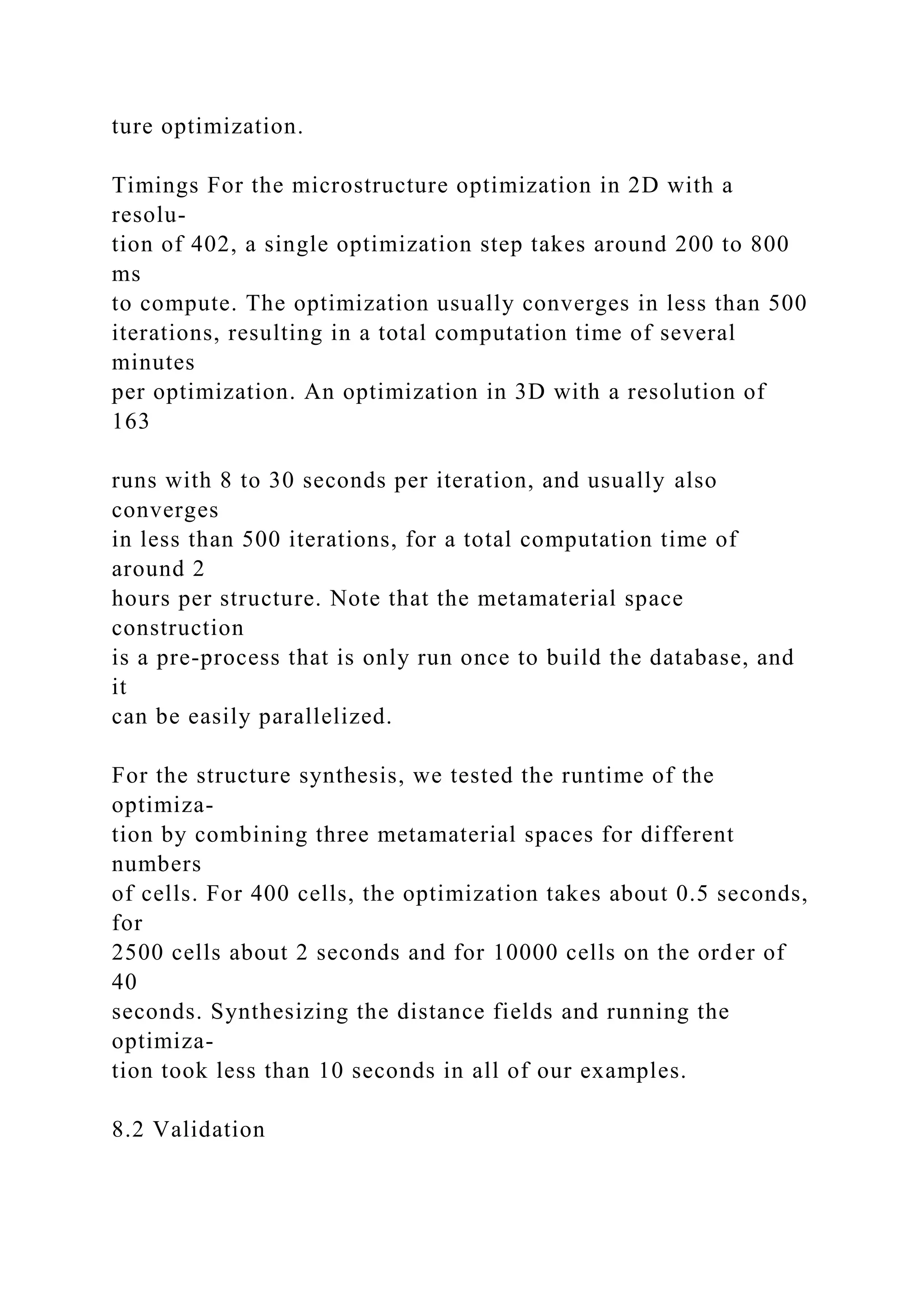

![0.15
0.2
0.25
0.3
0.35
0.4
0.45
0.5
Relative Young’s modulus [−]
Po
is
so
n
’s
ra
ti
o
[−
]
1](https://image.slidesharecdn.com/acmreferenceformatschumacherc-221014034045-09a470de/75/ACM-Reference-FormatSchumacher-C-Bickel-B-Rys-J-Mar-docx-58-2048.jpg)
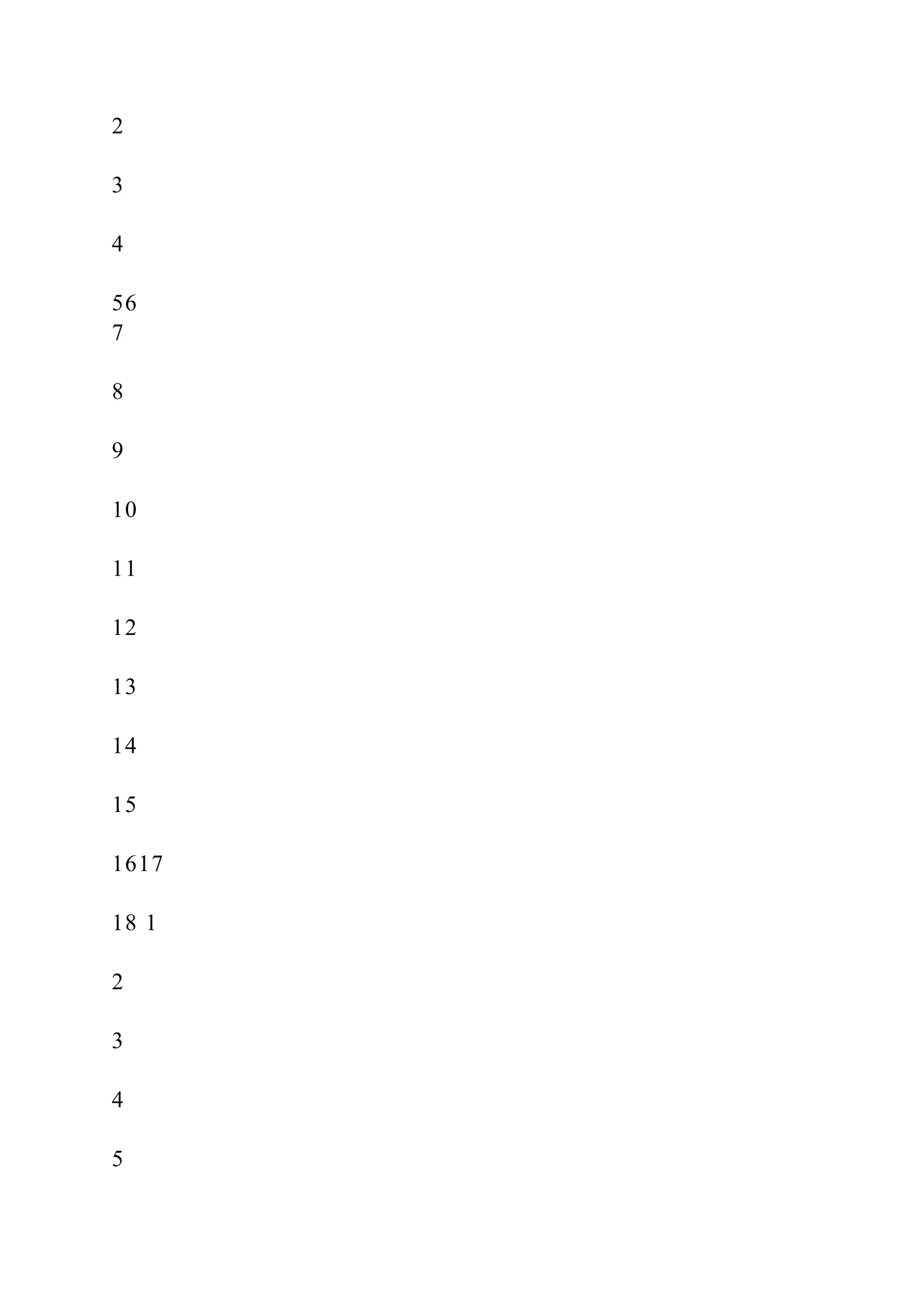
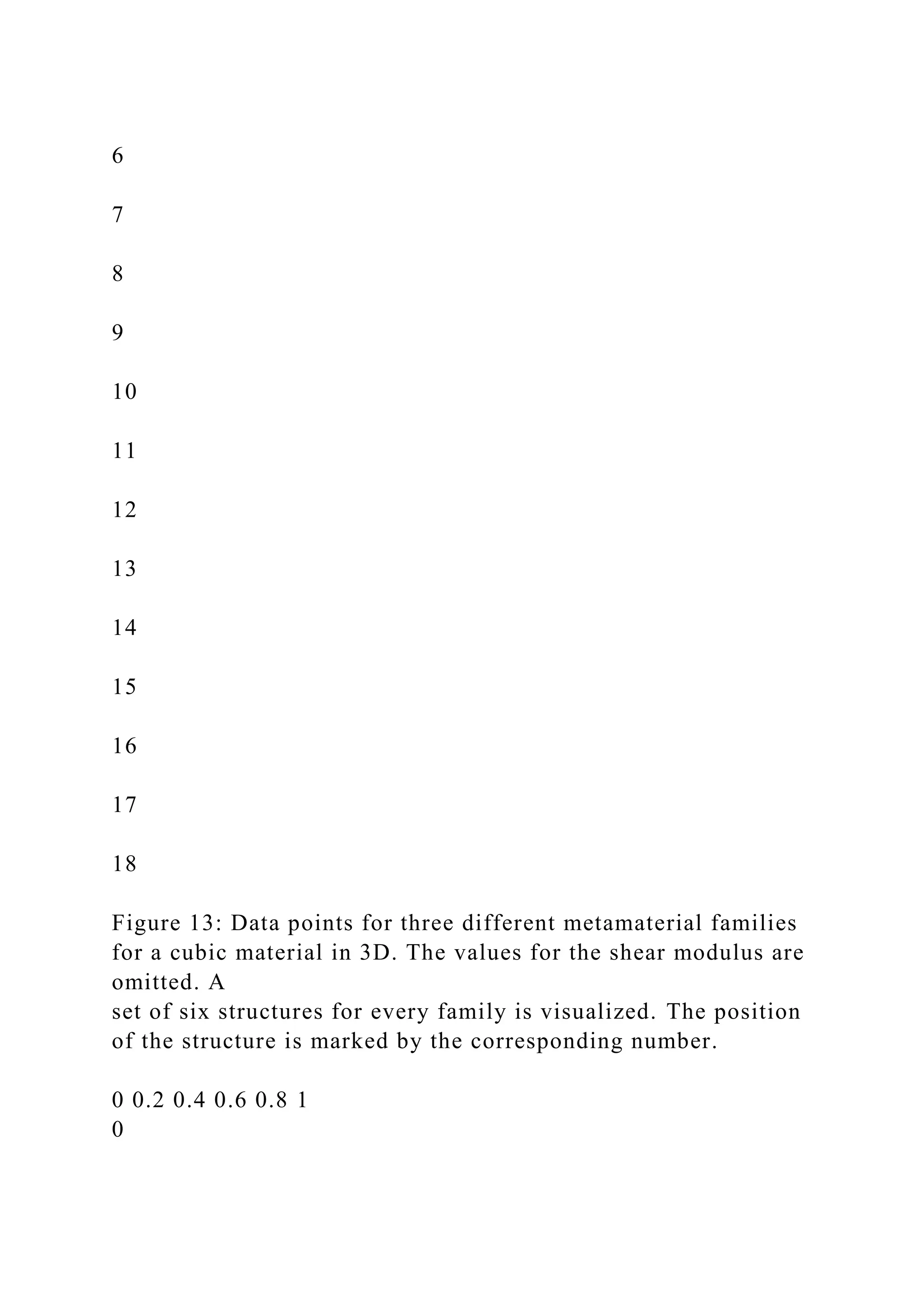
![0.1
0.2
0.3
0.4
0.5
0.6
0.7
0.8
0.9
1
Relative Young’s modulus E
x
[−]
R
e
la
ti
v
e
Y
o
u
n](https://image.slidesharecdn.com/acmreferenceformatschumacherc-221014034045-09a470de/75/ACM-Reference-FormatSchumacher-C-Bickel-B-Rys-J-Mar-docx-61-2048.jpg)
![g
’s
m
o
d
u
lu
s
E
y
[
−
]
0 0.2 0.4 0.6 0.8 1
0
0.1
0.2
0.3
0.4
0.5
0.6
0.7
0.8](https://image.slidesharecdn.com/acmreferenceformatschumacherc-221014034045-09a470de/75/ACM-Reference-FormatSchumacher-C-Bickel-B-Rys-J-Mar-docx-62-2048.jpg)
![0.9
1
Relative shear modulus [−]
R
e
la
ti
v
e
Y
o
u
n
g
’s
m
o
d
u
lu
s
E
y
[
−
]](https://image.slidesharecdn.com/acmreferenceformatschumacherc-221014034045-09a470de/75/ACM-Reference-FormatSchumacher-C-Bickel-B-Rys-J-Mar-docx-63-2048.jpg)
![0 0.2 0.4 0.6 0.8 1
−2
−1.5
−1
−0.5
0
0.5
1
1.5
Relative Young’s modulus E
x
[−]
P
o
is
s
o
n
’s
r
a
ti](https://image.slidesharecdn.com/acmreferenceformatschumacherc-221014034045-09a470de/75/ACM-Reference-FormatSchumacher-C-Bickel-B-Rys-J-Mar-docx-64-2048.jpg)
![o
ν
y
x
[
−
]
0 0.2 0.4 0.6 0.8 1
−2
−1.5
−1
−0.5
0
0.5
1
1.5
Relative shear modulus [−]
P
o
is
s
o](https://image.slidesharecdn.com/acmreferenceformatschumacherc-221014034045-09a470de/75/ACM-Reference-FormatSchumacher-C-Bickel-B-Rys-J-Mar-docx-65-2048.jpg)
![n
’s
r
a
ti
o
ν
y
x
[
−
]
Figure 12: Data points for four different metamaterial families
for
an orthotropic material in 2D. We show the relative Young’s
moduli
Ex and Ey the x-direction and y-direction, the relative shear
mod-
ulus and the Poisson’s ratio νyx that describes the contraction in
x-direction for an extension applied to the y-direction.
Figure 14: The
test setup.
Test Setup and Method We used an Instron
E3000 frame with a 5 kN load cell for the ma-
terial test. For the 2D structures, we performed
tensile tests using a 10 cm pneumatic grip (Fig-
ure 14). We fist characterized the base mate-
rial using dog-bone shaped structures. To mea-
sure the tensile strength of the microstructures,](https://image.slidesharecdn.com/acmreferenceformatschumacherc-221014034045-09a470de/75/ACM-Reference-FormatSchumacher-C-Bickel-B-Rys-J-Mar-docx-66-2048.jpg)
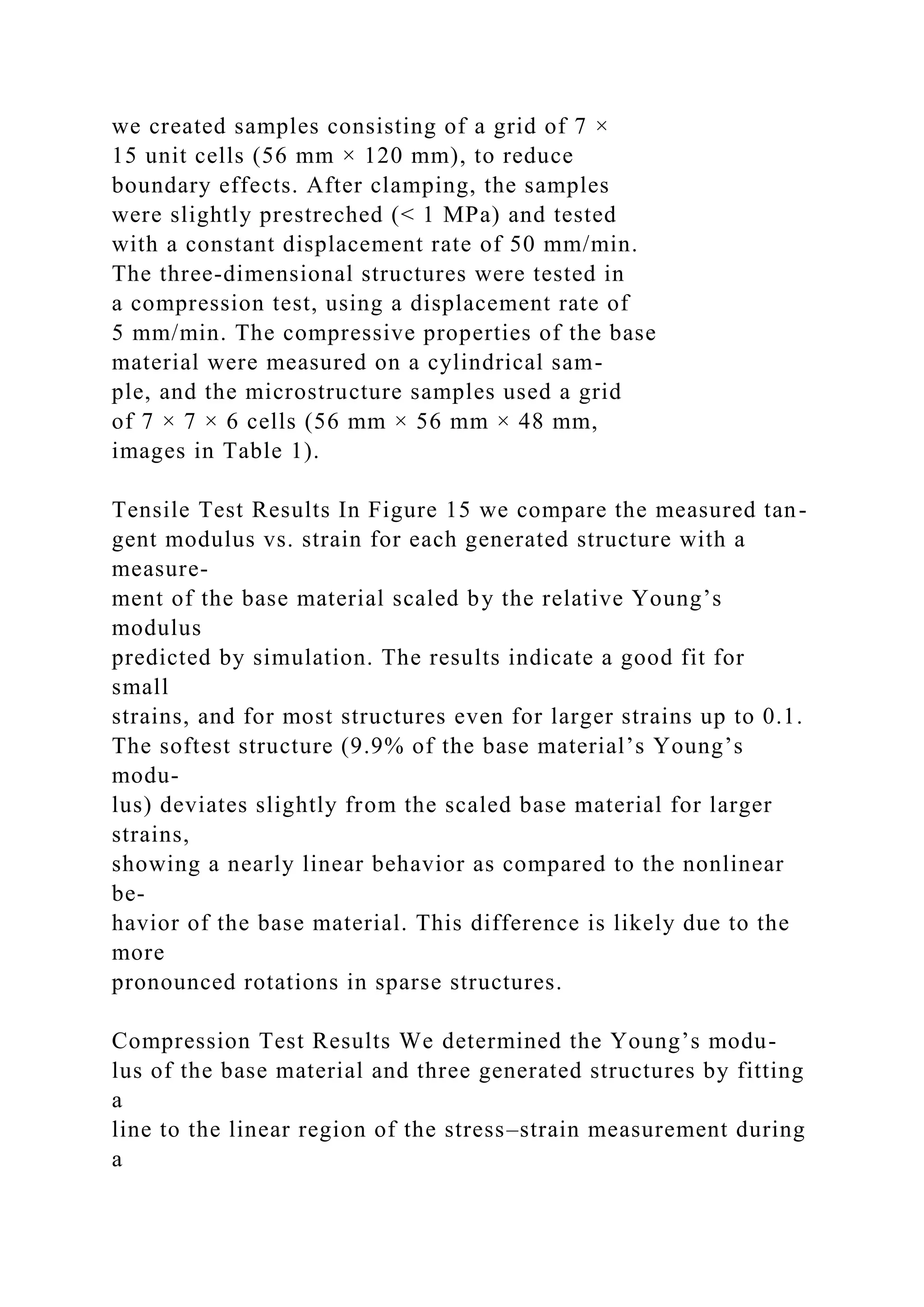
![loading phase. Table 1 shows that the predicted and measured
rel-
ative Young’s modulus match reasonably well. The stress–strain
plots as well as the linear fits can be found in the supplemental
doc-
ument.
0 0.02 0.04 0.06 0.08 0.1
0
5
10
15
20
25
Engineering strain [−]
Ta
n
g
en
t
m
o
d
u
lu](https://image.slidesharecdn.com/acmreferenceformatschumacherc-221014034045-09a470de/75/ACM-Reference-FormatSchumacher-C-Bickel-B-Rys-J-Mar-docx-68-2048.jpg)
![s
[M
Pa
]
base material
structure 1
50.1% base material
structure 2
24.6% base material
structure 3
9.9% base material
0 0.02 0.04 0.06 0.08 0.1
0
5
10
15
20
25
Engineering strain [−]
Ta
n
g](https://image.slidesharecdn.com/acmreferenceformatschumacherc-221014034045-09a470de/75/ACM-Reference-FormatSchumacher-C-Bickel-B-Rys-J-Mar-docx-69-2048.jpg)
![en
t
m
o
d
u
lu
s
[M
Pa
]
base material
structure 4 (x−direction)
50.6% base material
structure 4 (y−direction)
20.5% base material
Figure 15: Tensile test results for a number of microstructures.
Top: Test results for synthesized microstructures with a
Young’s
modulus of 9.9%, 24.6% and 50.1% of the base material. The
scaled curve of the base material is shown for reference.
Bottom:
Test results for interpolated microstructures with orthotropic
ma-
terial behavior. The computed Young’s moduli were 20.5% and
50.6% of the base material’s Young’s modulus.](https://image.slidesharecdn.com/acmreferenceformatschumacherc-221014034045-09a470de/75/ACM-Reference-FormatSchumacher-C-Bickel-B-Rys-J-Mar-docx-70-2048.jpg)
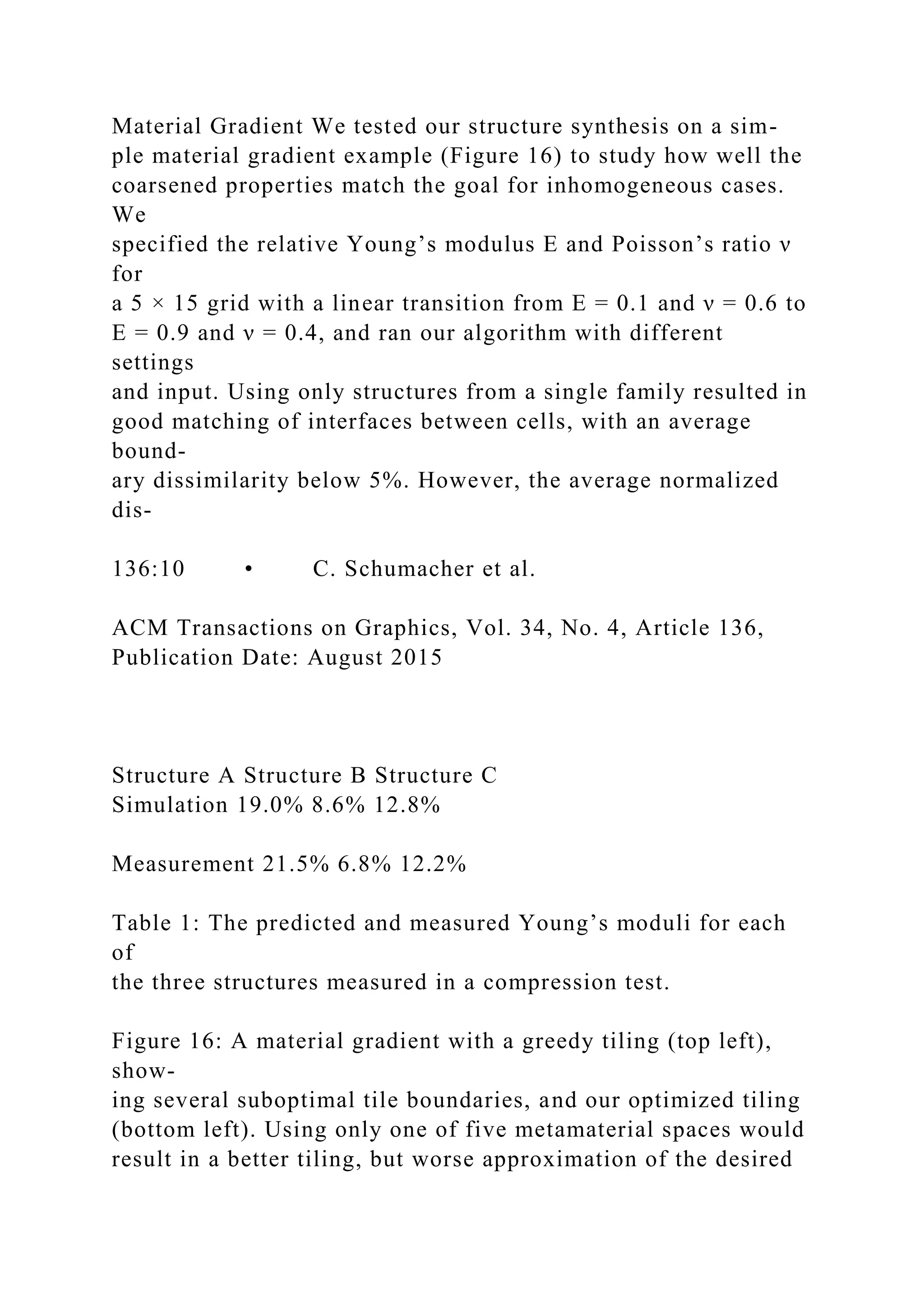
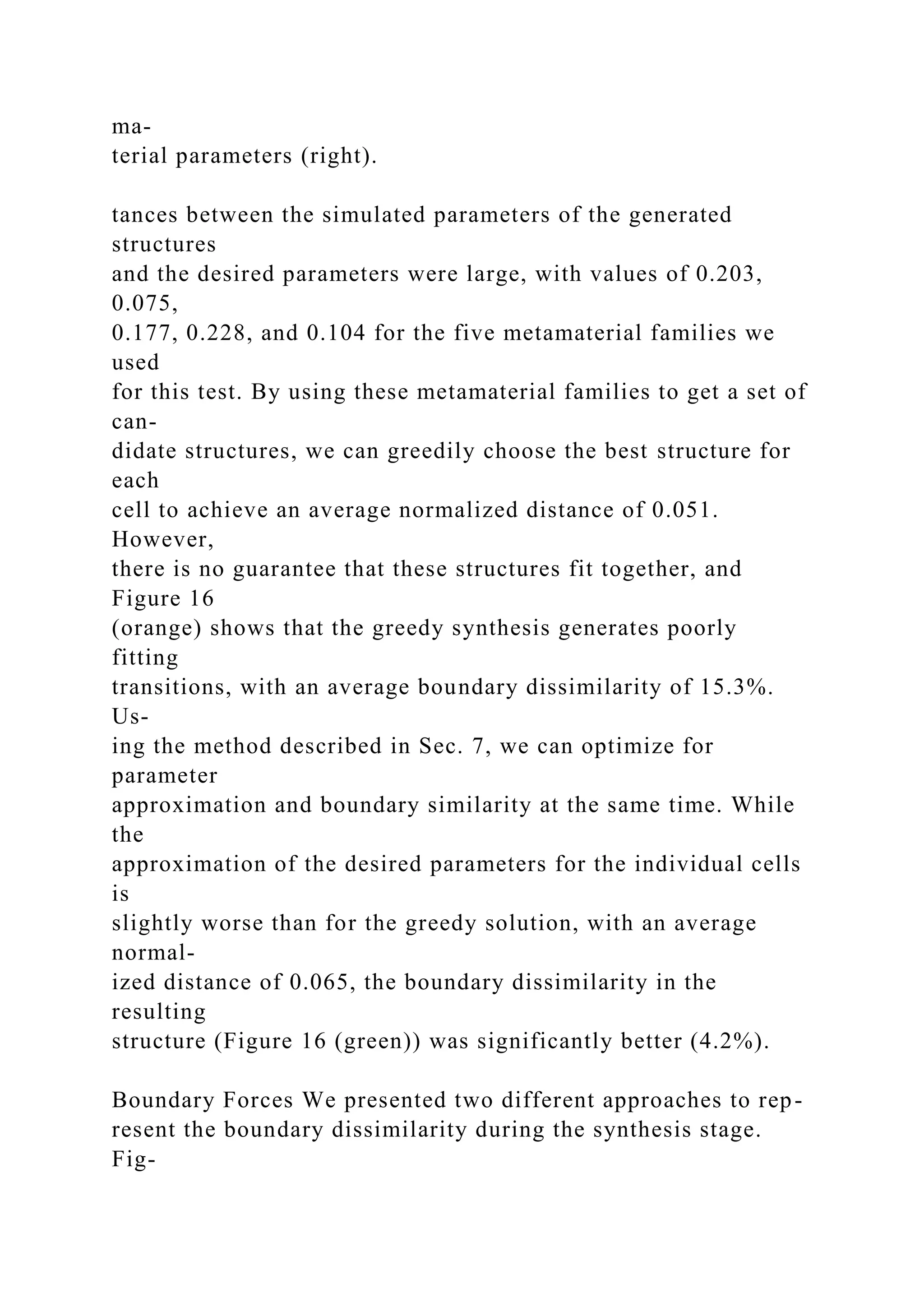
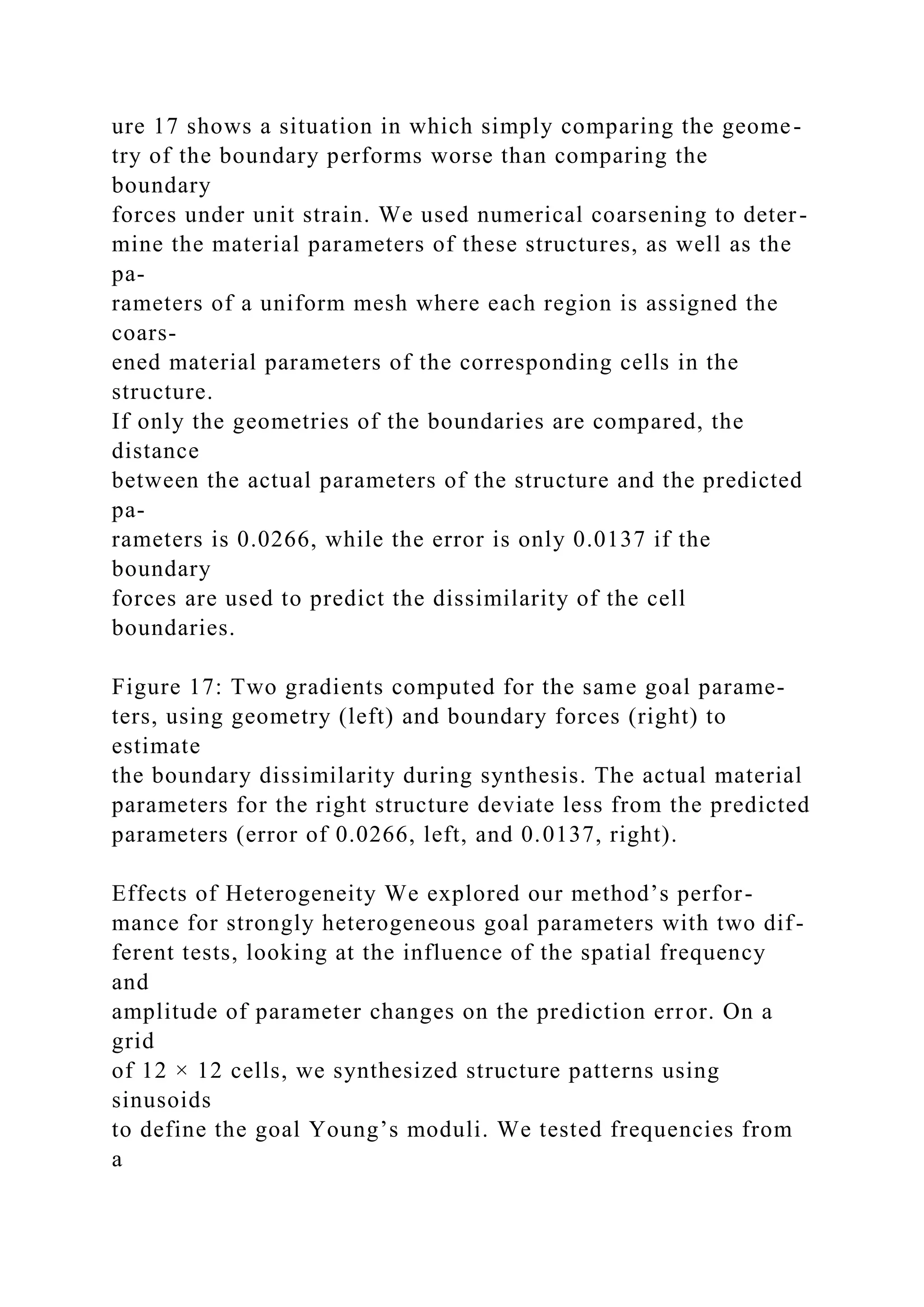
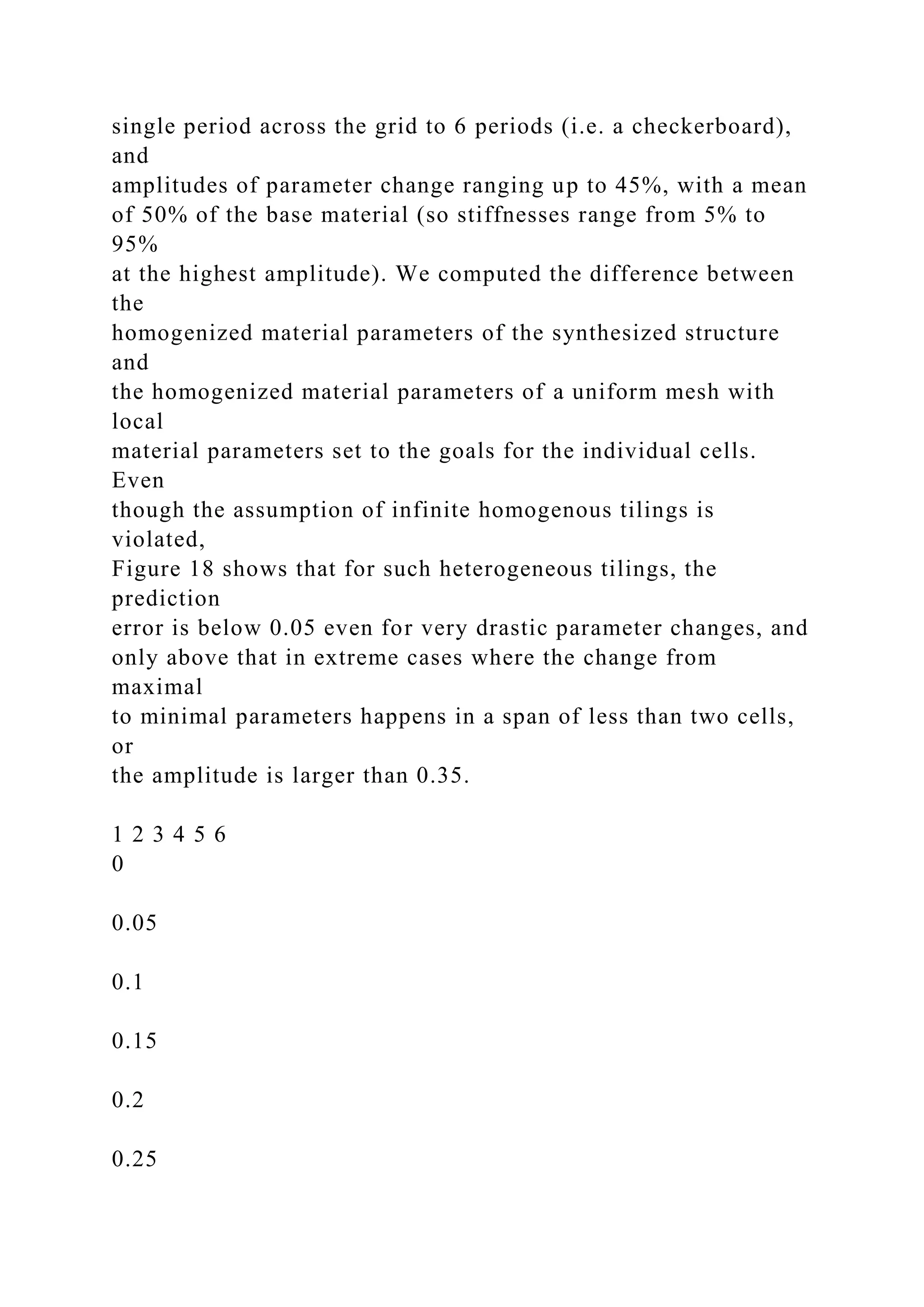
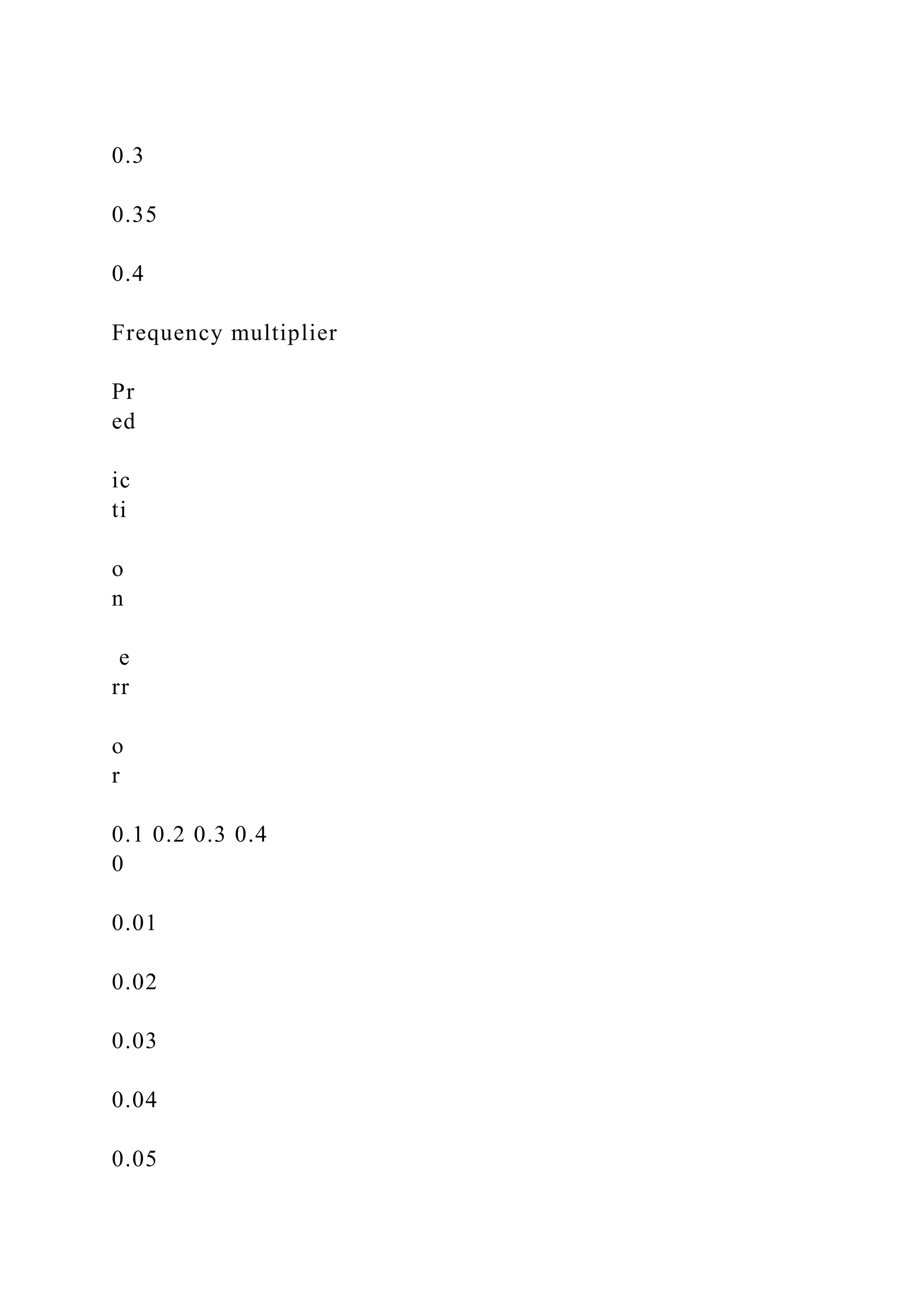

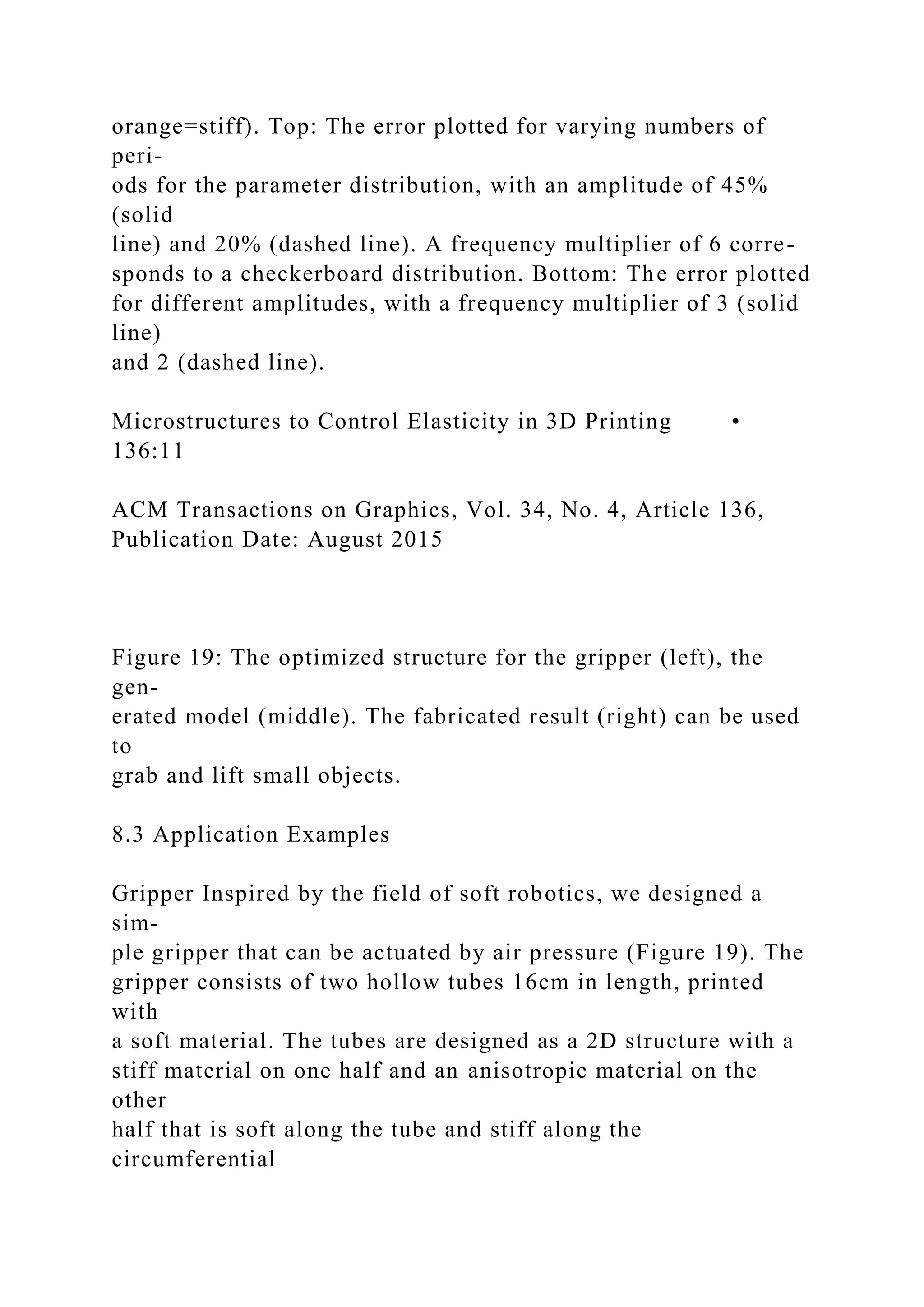
![direction. A balloon is inserted into each tube, and increasing
the
pressure inside the balloons causes the tubes to bend due to the
dif-
ference in stiffness. At the same time, the anisotropy of the
struc-
ture prevents large changes in diameter. While this is only a
very
simple actuator, we believe that our method will be an
important
step towards a design tool for printable soft robots.
Bunny, Teddy, and Armadillo For the three-dimensional case,
we tested our pipeline on two models (Bunny, 13 cm high;
Teddy,
15 cm) with spatially varying Young’s moduli, created with an
in-
teractive material design tool [Xu et al. 2015]. The models were
subdivided into cells with 8 mm side length, and the Young’s
mod-
uli averaged for each cell. The metamaterial space used to
populate
these cells contained a single family of 21 microstructures. For
synthesis, we chose the nearest neighbor in the database for
each
Young’s modulus. To keep the shape of the models, the
individual
voxels of each structure were set to void if they lay outside of
the
model. While this might lead to disconnected components in the
re-
construction, these can easily be removed. We created a third
model
(Armadillo, 32 cm high) by manually painting the desired
Young’s
modulus into a volumetric mesh, which was then used as an](https://image.slidesharecdn.com/acmreferenceformatschumacherc-221014034045-09a470de/75/ACM-Reference-FormatSchumacher-C-Bickel-B-Rys-J-Mar-docx-78-2048.jpg)
